Are you pushing into your late 50s and have a bit of cash to splash on a two-door performance car? Look no further than the Ford Mustang.
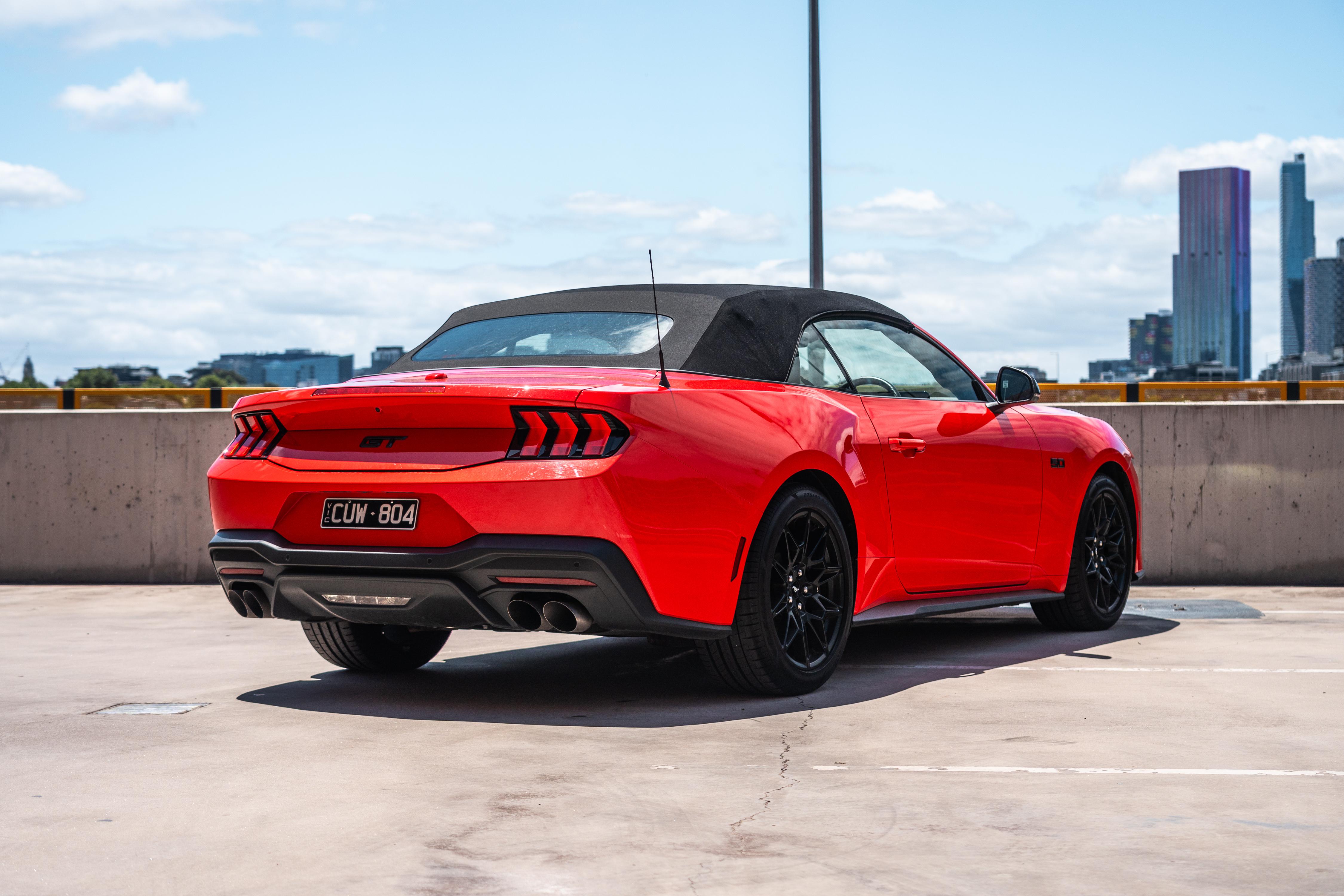
As sure as it continues to attract a ‘specific’ clientele, the Mustang is still just as brash as ever. This current ‘S650’ generation is larger than the previous one, despite being more of a heavy update than an all-new car, and it sports bold, aggressive styling that makes it immediately recognisable.
Importantly, it’s still available with Ford’s iconic ‘Coyote’ V8, even in a world of increasingly strict emissions regulations. A four-cylinder turbo is your alternative, as has been the case historically, but that’s not what the Mustang is about.
The V8 is the last of a dying breed too, with no direct rivals since the Chevrolet Camaro muscle car exited limited production at the end of 2023. And the the 2026 Ford Mustang GT Convertible on test here is even more special with its soft-top roof, as no other convertibles really compare.
More need not be said – is the Mustang really worth the hype?
How much does the Ford Mustang cost?
With the limited-edition Dark Horse coupe now sold out, the GT Convertible tops the Mustang range at $92,667 before on-road costs.
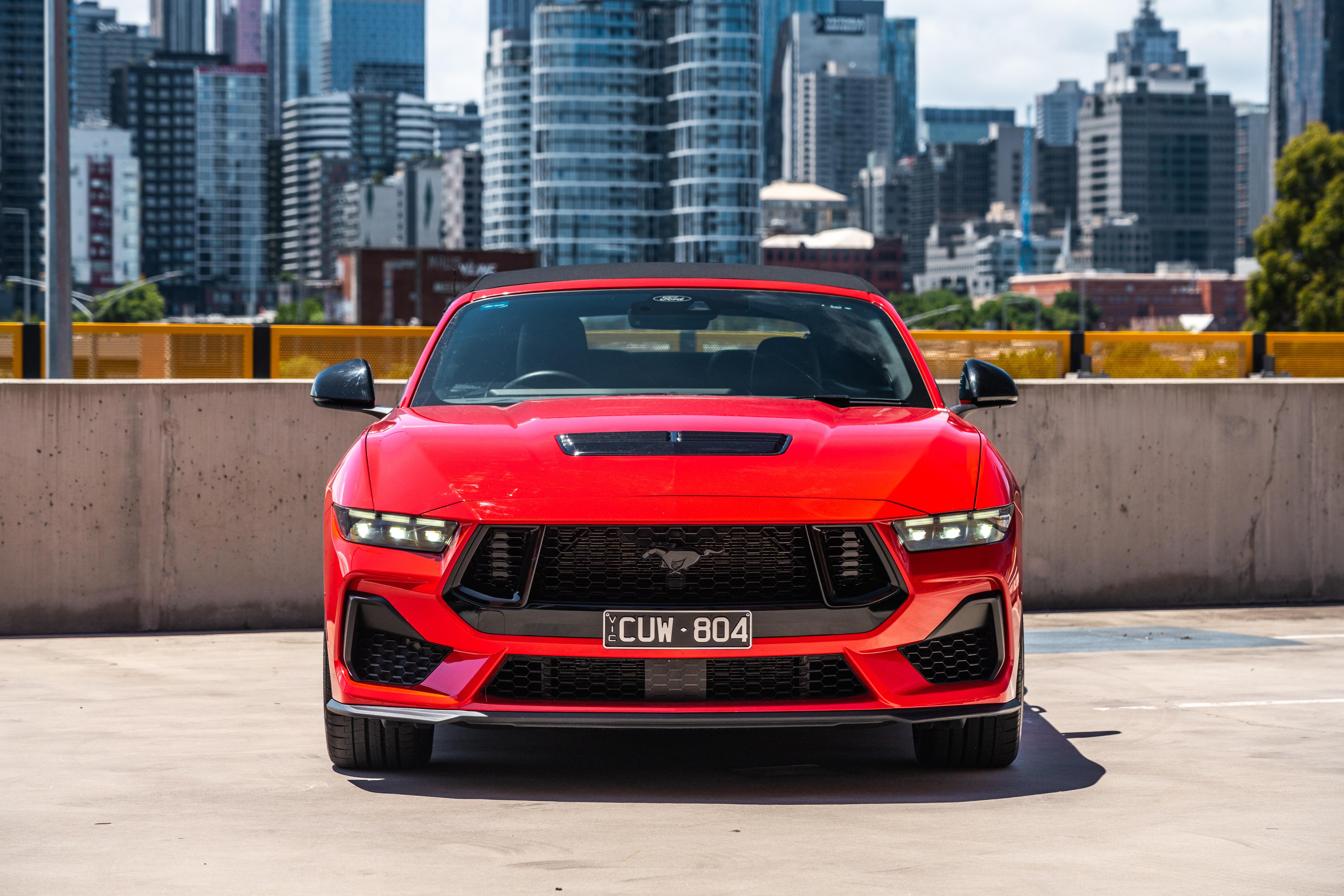
| Model | Price before on-road costs |
|---|---|
| 2026 Ford Mustang EcoBoost Fastback auto | $71,990 |
| 2026 Ford Mustang GT Fastback manual | $83,990 |
| 2026 Ford Mustang GT Fastback auto | $86,990 |
| 2026 Ford Mustang GT Convertible auto | $92,667 |
Even if Mustang prices keep creeping up, there are no direct rivals for this particular car in Australia, especially not at this price point. The next-cheapest convertible V8 is the Chevrolet Corvette Stingray at $204,490 before on-roads, which is an astronomical price jump.
The Mustang coupe still has the usual rear-drive two-door competitors, though: the Toyota Supra and the Nissan Z. These aren’t convertibles or V8s, and the Supra isn’t even available to order anymore (the top-spec GTS was priced at $96,290 before on-roads).
That leaves the Z, which tops out at $76,160 before on-roads in standard form, or $94,605 before on-roads for the hotter Nismo version.
To branch out a bit, there’s also the BMW M240i, priced at $102,100 before on-road costs.
To see how the Ford Mustang stacks up against its rivals, use our comparison tool
What is the Ford Mustang like on the inside?
Not for the traditionalists, but there’s a premium feel to it all.
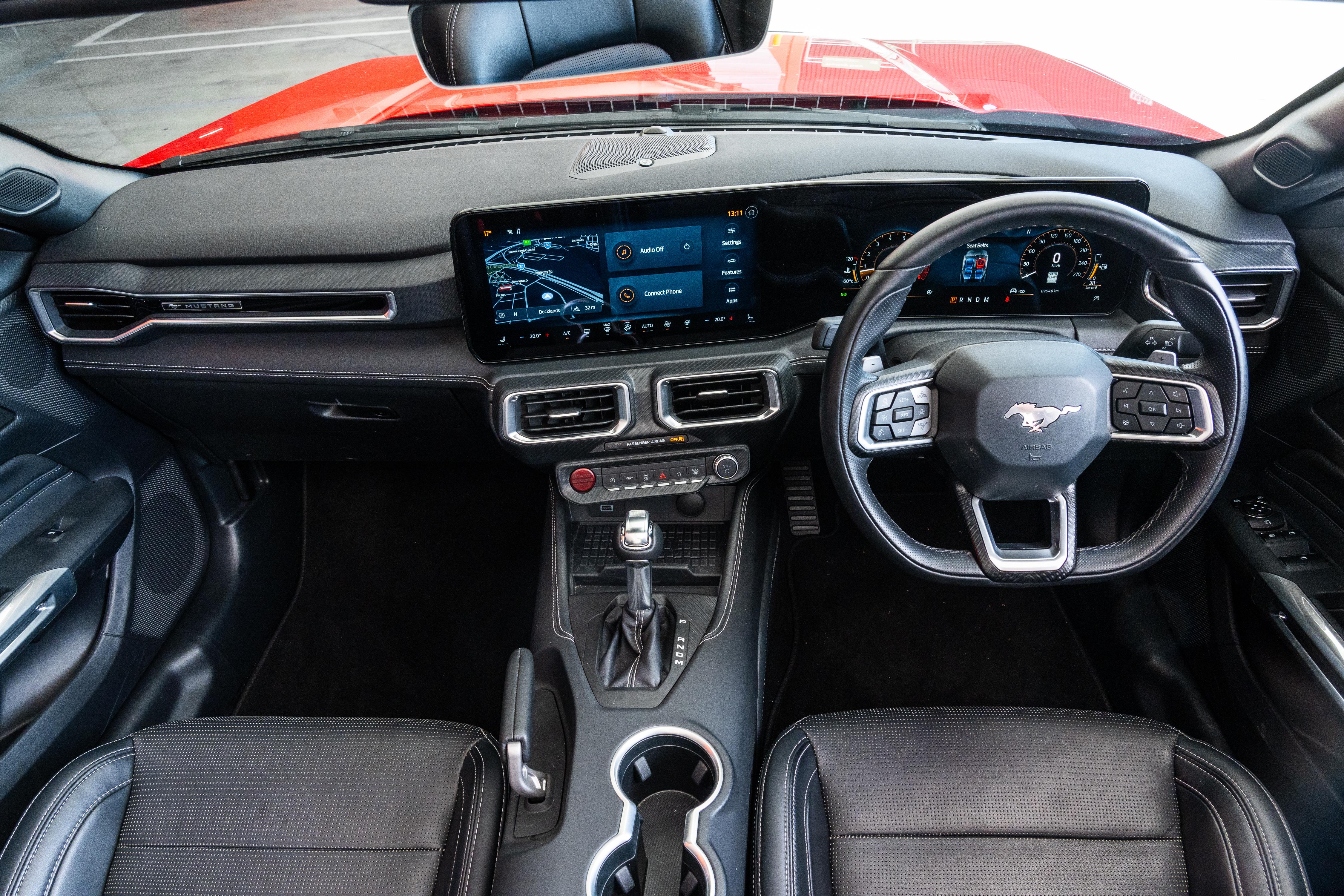
On the dashboard, a large, flat panel houses two large screens. In isolation you wouldn’t imagine these generic displays slotting nicely into a car with the Mustang’s character, but they’re modern, clean, and make the cabin a more convenient place to be.
On the left is a 13.2-inch infotainment system, which doubles as the car’s main control centre. Naturally, there are countless native apps, from navigation to interior customisation, but the big thing for enthusiasts is the broad array of performance-oriented apps.
The ‘Pony’ button below the screen serves as a shortcut to Mustang goodness. Ford lets you adjust interior colours, exhaust volumes, and custom drive modes, while also providing several ‘track apps’ like line lock and launch control.
Additionally, you can bring up a selection of auxiliary gauges for G-forces, battery voltage, oil pressure, and more. It’s the level of customisation that car lovers dream of as kids.
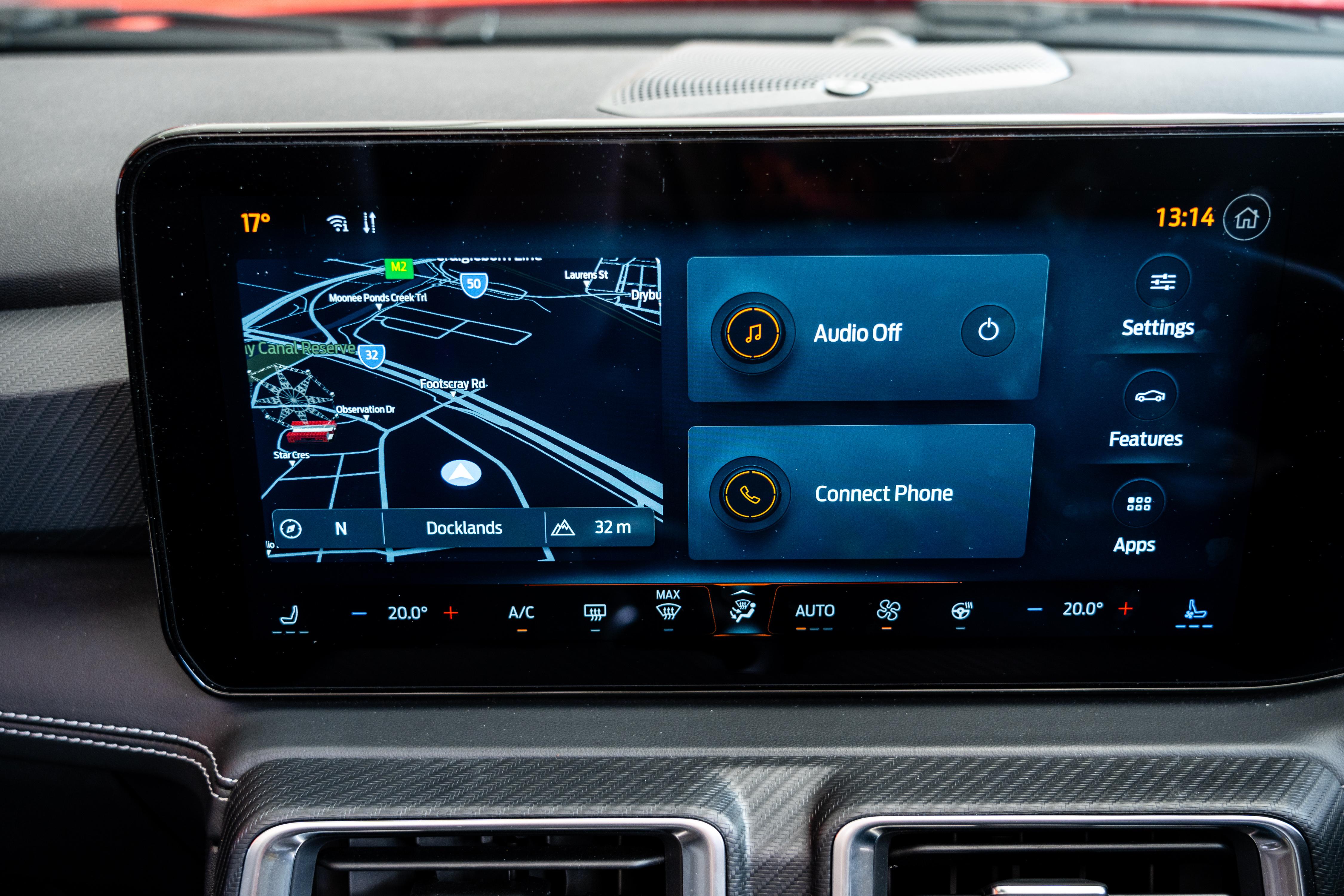
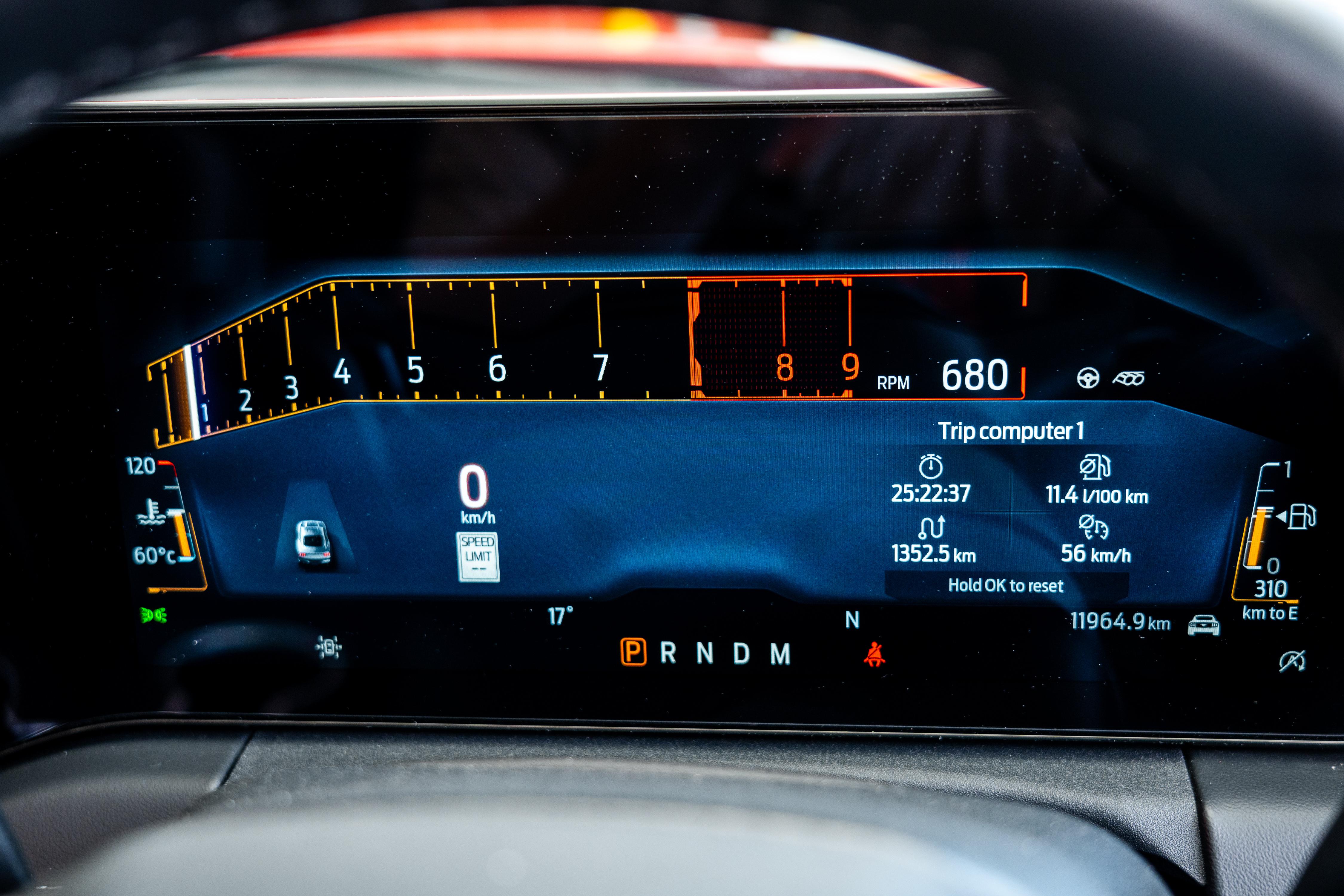

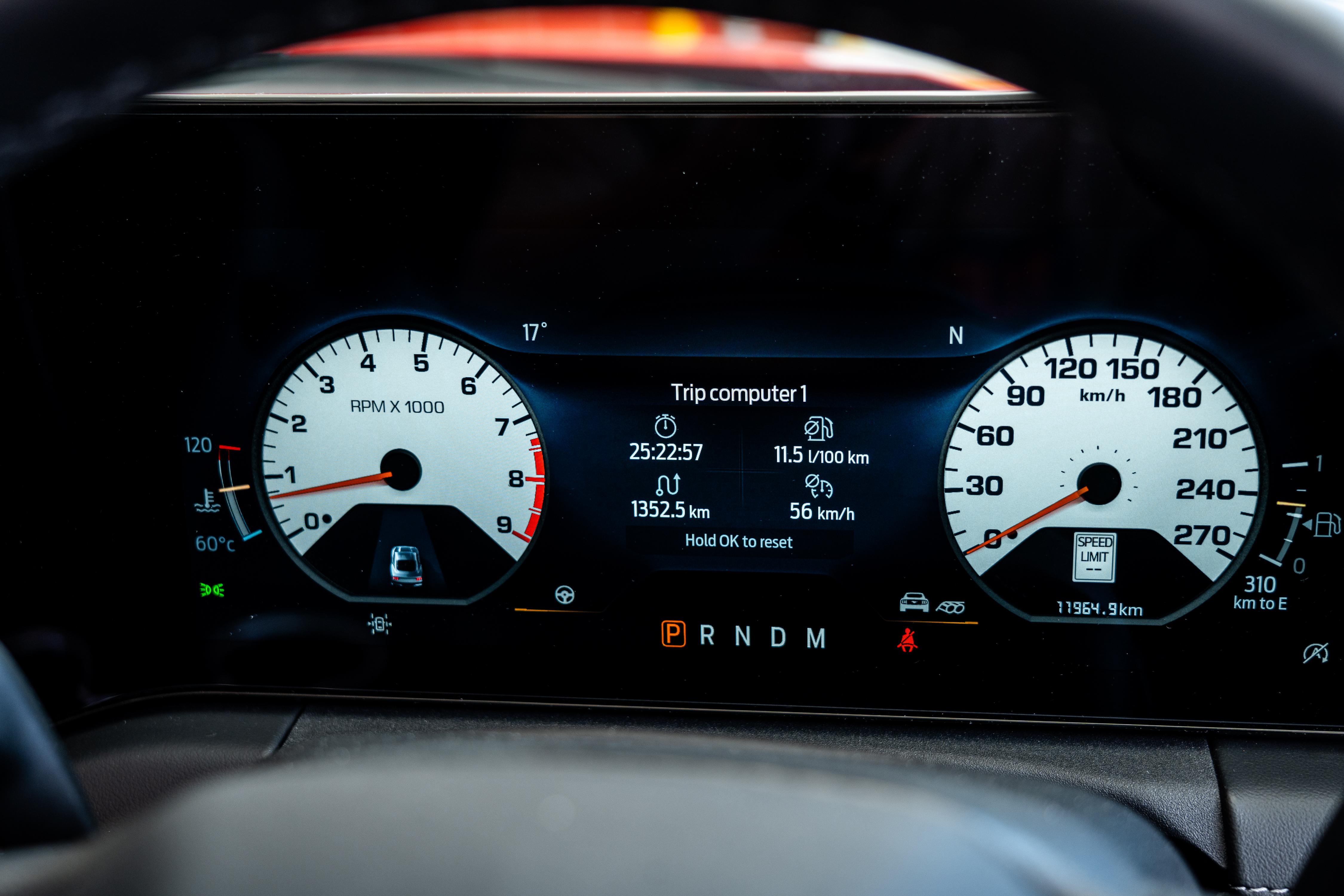
It gets even better when you shift across to the 12.4-inch digital instrument display. Its standard layout is tidy and fits the edgy, modern vibe of Ford’s latest user interfaces, but it goes the extra mile with several unique themes.
These are inspired by Mustang instruments from across the generations, namely the old-school first-gen dials of the 1960s, retro green-tinted ones from the late 1980s Foxbody, and the white-face ‘New Edge’ dials from the early 2000s SVT Cobra. This is just so cool.
We acknowledge it can be somewhat tacky to put old gauges on a digital screen, but we still love it.
There are also a couple of modern styles, including a full-on race-like setup with a huge rev counter, and you can adjust how much information is shown for temperatures and pressures.
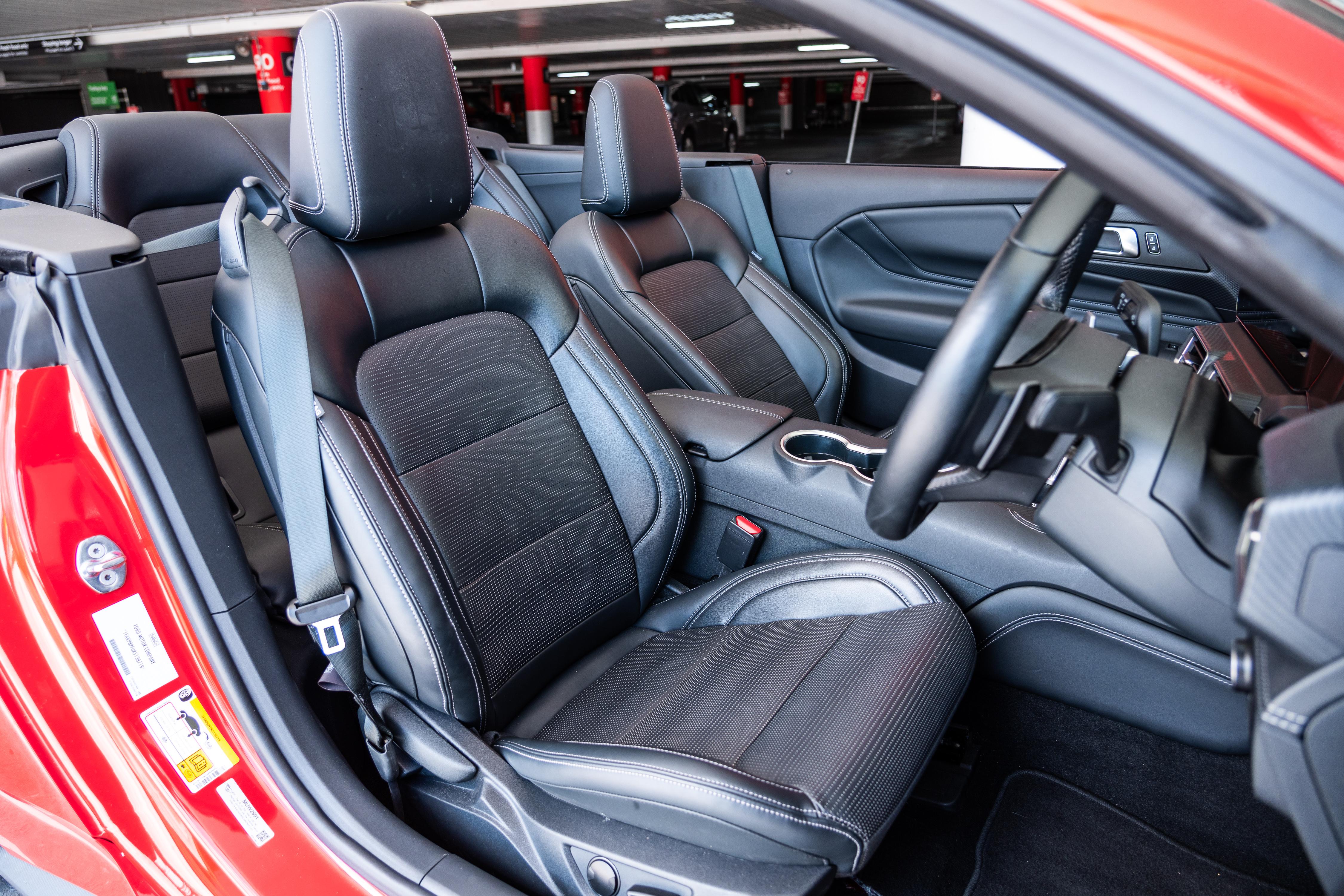

It’s a highly customisable setup, best experienced by playing with it yourself. Topping it off is a range of vibrant colours for the interior ambient lighting, along with detailed animations for each drive mode – a display of personality not seen in many current rivals.
Our one complaint is that the climate control system is purely digital. It’s a little finicky, especially when on the move, and we’d much prefer a physical arrangement even at the expense of an uncluttered interior.
Fortunately, the key touch points are all high-quality, and ergonomics are excellent. There’s a chunky leather-clad steering wheel with plenty of physical buttons, and the leather-appointed seats are nicely bolstered and comfortable, remaining supportive in higher-intensity driving.
The parking brake lever looks cable-operated, but it’s actually electric. It’s unfortunate that it feels somewhat flimsy and unintuitive to operate, while the car’s left-hand drive origins mean it’s on the wrong side of the centre console in Australia – it does double as a drift brake, though.

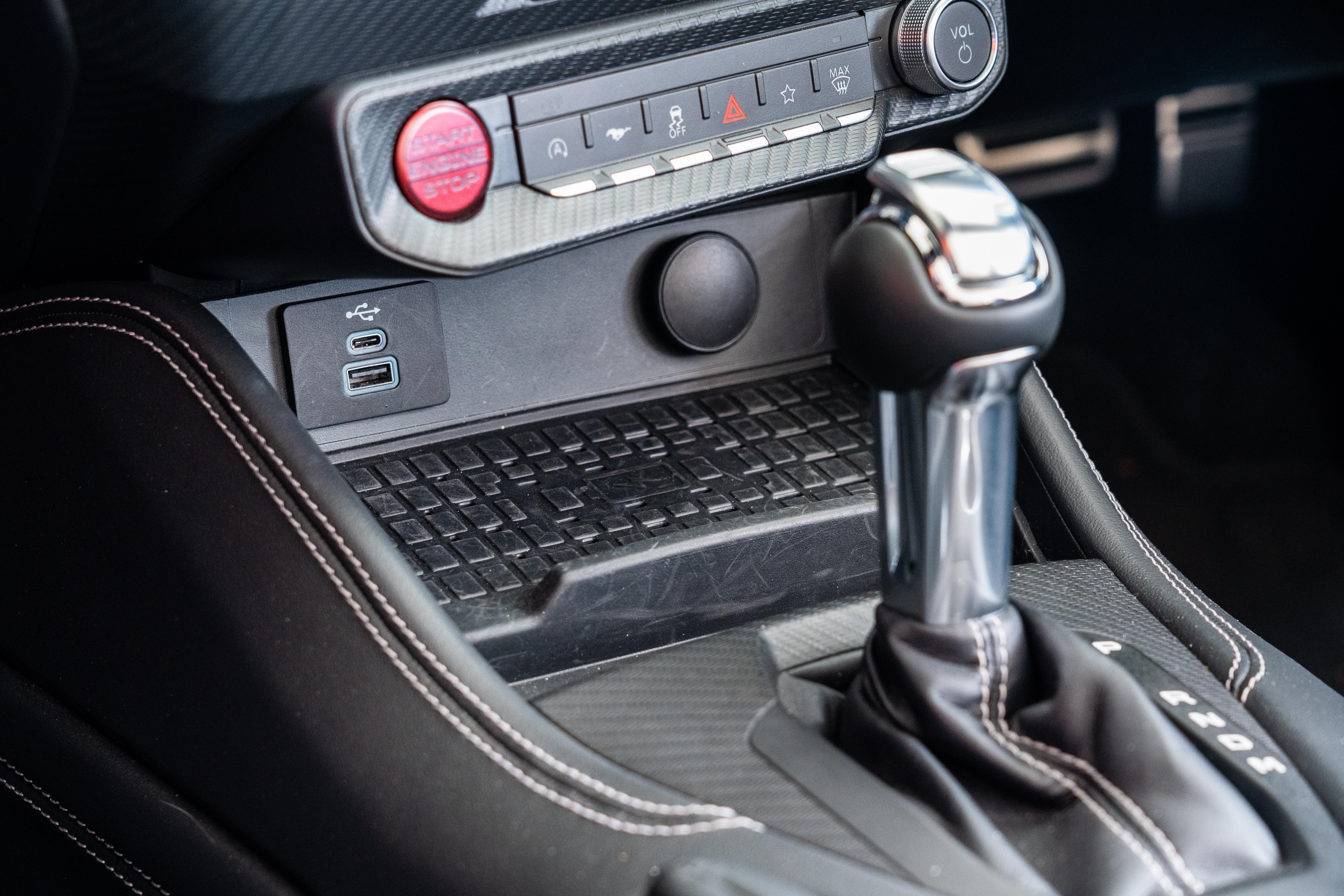
Storage is understandably limited to a passenger-side glovebox and a pair of cupholders, though there’s a rubberised wireless phone charging pad below a pair of USB ports and 12V outlet to hold your phone.
As expected, the rear seats are only really useful if your passengers don’t have legs, or if the front-row occupants are particularly short. Ford has still fitted a set of ISOFIX child seat anchors back here for family-oriented owners.
While the convertible roof certainly adds charm to the Mustang, it’s not without its flaws either. Some of which are related to driving, which will be detailed later on, but the main ones are to do with construction and fitment.
For one, a quick wash left some water streaking down the inside of the windows. I know leaks aren’t unusual for soft-tops, but while it’s annoying in an old convertible with worn rubber seals, it’s not at all befitting of a car that costs nearly $100,000.
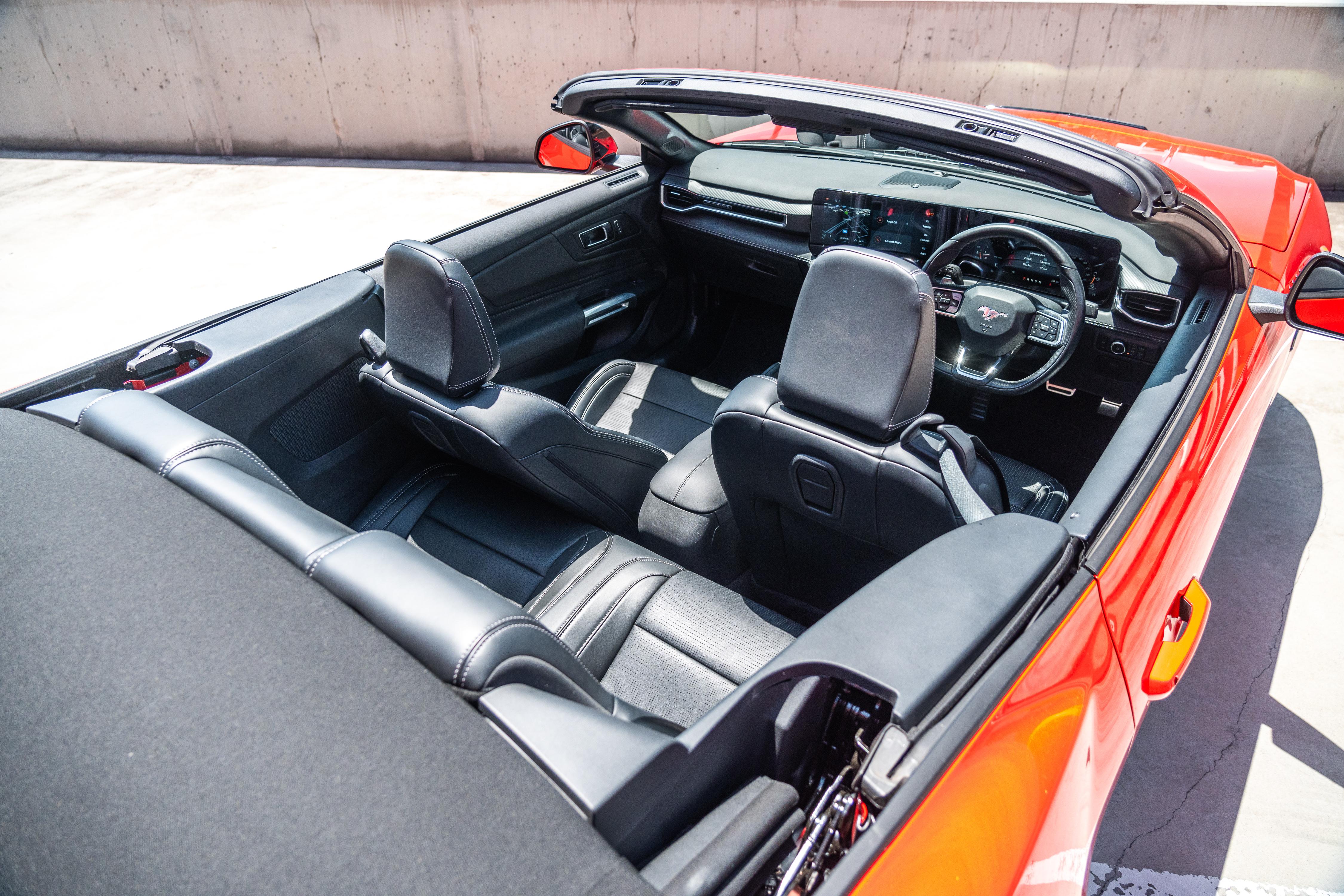
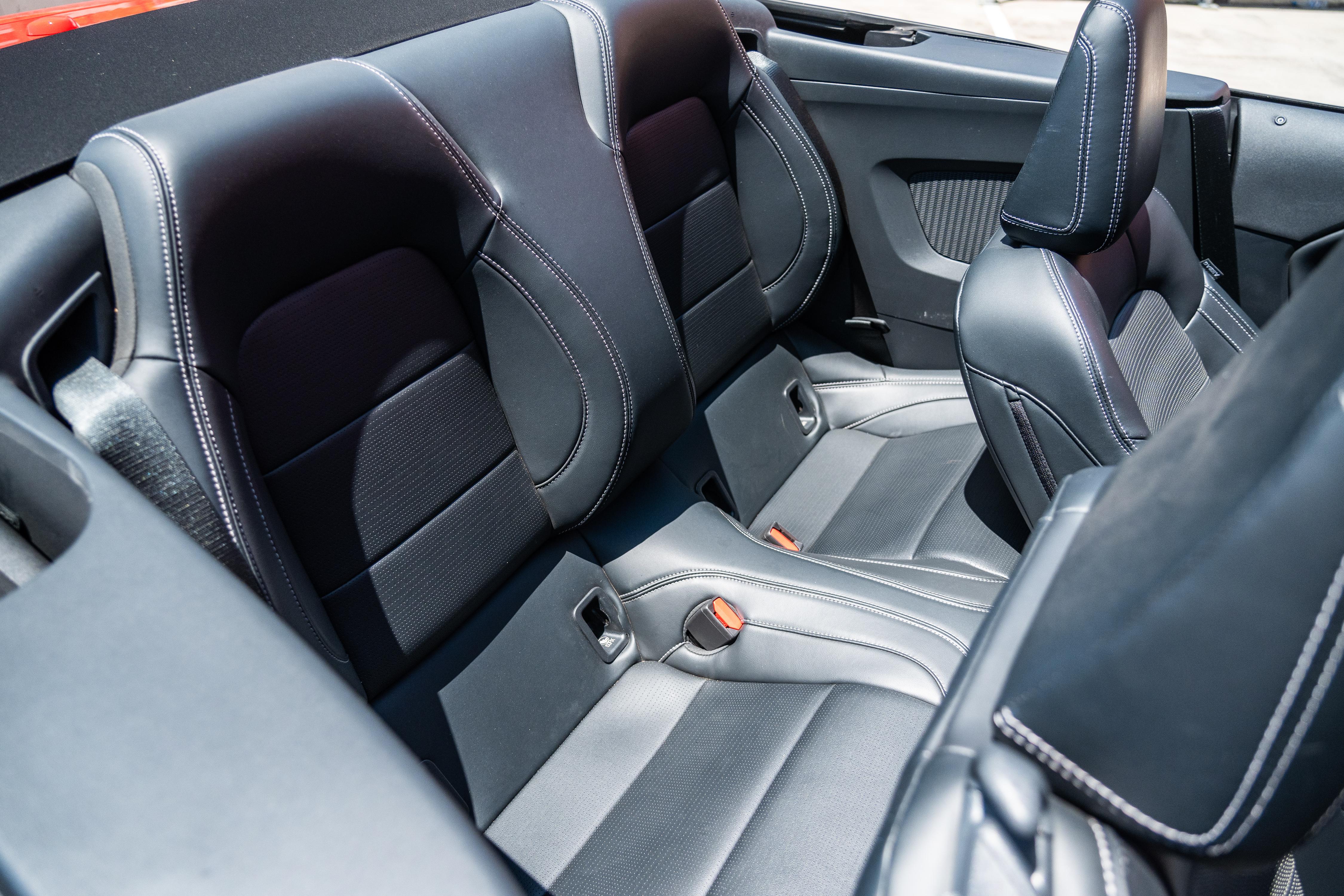
Then there’s Ford’s solution to hiding the folding mechanism once it’s open. The body panels don’t obscure the unsightly componentry – instead, Ford gives you a pair of flimsy plastic covers that loosely slot between the roof, the interior ‘B-pillar’ plastics, and the body panels.
This solution is hardly elegant and needlessly fiddly, especially as the panels feel like they could blow away on the freeway. It also detracts from the convenience of an electric roof.
But underneath is an unexpectedly large boot, consistent with other Mustangs, though there’s no quoted capacity.
This adds loads of practicality to an otherwise compromised package, but you’ll have to make do with a tyre repair kit rather than a spare wheel.
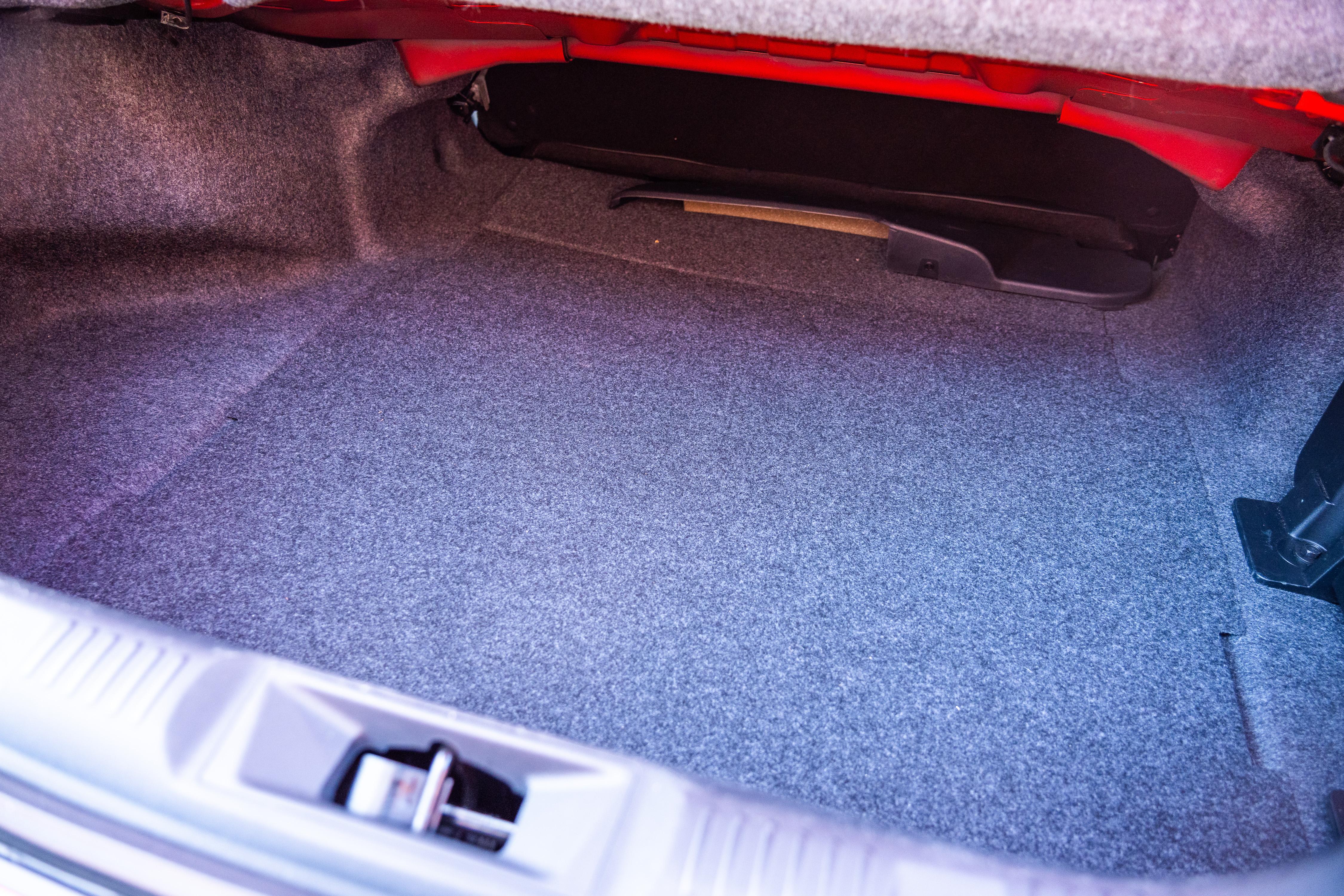
| Dimensions | Ford Mustang GT Convertible |
|---|---|
| Length | 4811mm |
| Width | 2097mm |
| Height | 1408mm |
| Wheelbase | 2719mm |
| Cargo capacity | – |
To see how the Ford Mustang stacks up against its rivals, use our comparison tool
What’s under the bonnet?
The iconic 5.0-litre ‘Coyote’ V8 continues to grace us with its presence, pumping out no less than 345kW of power and 550Nm of torque in locally delivered Mustang GTs. This is down from ~360kW and ~567Nm in the US.
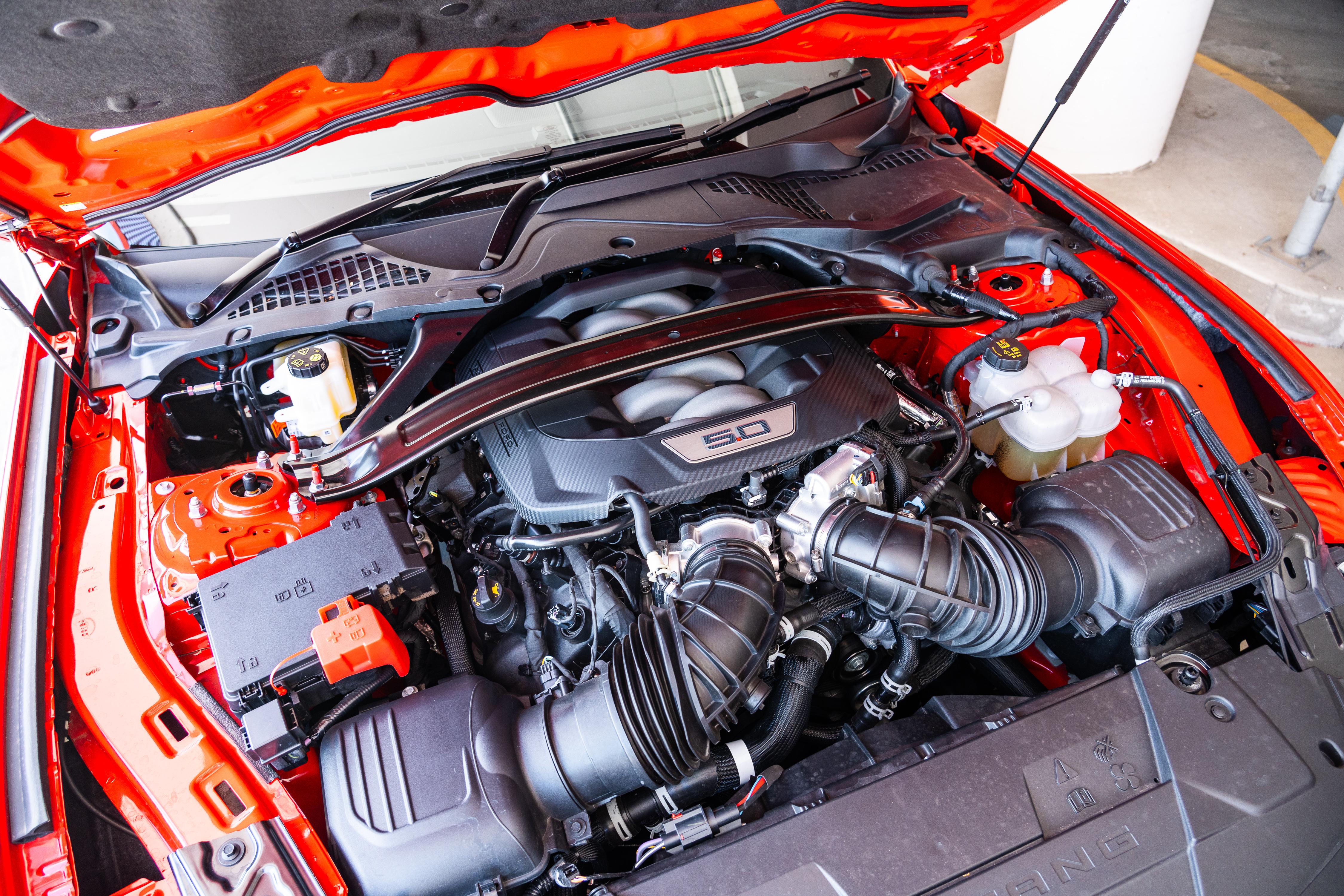
| Specifications | Ford Mustang GT Convertible |
|---|---|
| Engine | 5.0L V8 naturally aspirated petrol |
| Power | 345kW |
| Torque | 550Nm |
| Transmission | 10-speed auto |
| Drive type | Rear-wheel drive |
| Kerb weight | 1872kg |
| 0-100km/h (claimed) | 4.9 seconds |
| Fuel economy (claimed) | 12.8L/100km |
| Fuel economy (as tested) | 10.8L/100km |
| Fuel tank capacity | 61L |
| Fuel requirement | 98-octane premium unleaded |
| CO2 emissions | 293g/km |
The GT Convertible is one of two Mustang variants that aren’t available with a manual gearbox, the other being the EcoBoost. Drive is sent exclusively to the rear wheels, regardless of the variant.
Our as-tested fuel economy figure is a testament to the Mustang’s serviceability as a cruiser. Given that most of our week was spent on freeways or 100km/h country roads, the Coyote was able to hum along at low RPM and low load, keeping fuel consumption below Ford’s claim.
Even with a fair few instances of, er, “acceleration testing”, and a lengthy commute through suburban Melbourne at peak hour, the Convertible proved to be more frugal than expected.
That said, you can still watch the fuel gauge going down as you drive along – anything above 10L/100km is hardly economical by today’s standards.
To see how the Ford Mustang stacks up against its rivals, use our comparison tool
How does the Ford Mustang drive?
There isn’t much out there like the Mustang these days, much less at this price point, or with a canvas drop-top.
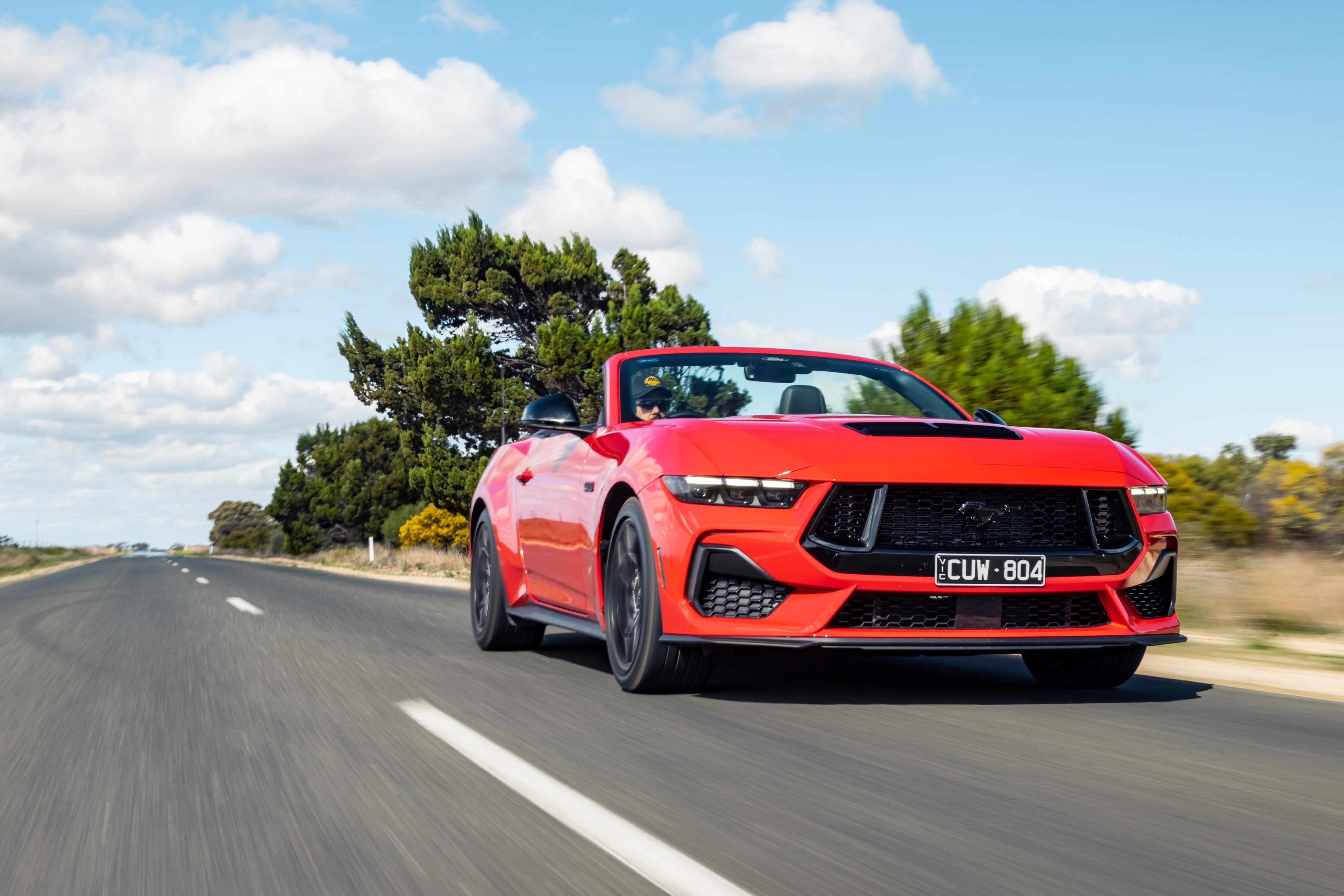
Of course, it’s easy to dismiss the Mustang by association with its cohort of yobbo drivers who like posting videos online of their cars making as much noise as possible. Things change once you actually drive one, though – for the better, mind you – as it’s actually quite fun to make a lot of noise.
Put it this way: full-throttle while roof-down on a long, uphill sweeping bend is one of, if not the best, auditory experiences I’ve had as a driver. I don’t care if that’s basic or clichéd.
And the best part is the Mustang will keep giving you the same authentic roar all day long. You’ll hear the characterful exhaust note echo along tree-lined roads, and the rev-flare on freeway on-ramps as the car scurries to get its power down – all made better with the roof down, of course.
Of course, I dislike loud and obnoxious exhausts as much as any bystander, and I know Mustang drivers are usually the worst offenders. That’s why I preferred driving Big Red out in the country, where the only offended ears may have belonged to cows, sheep, or the odd farmer.
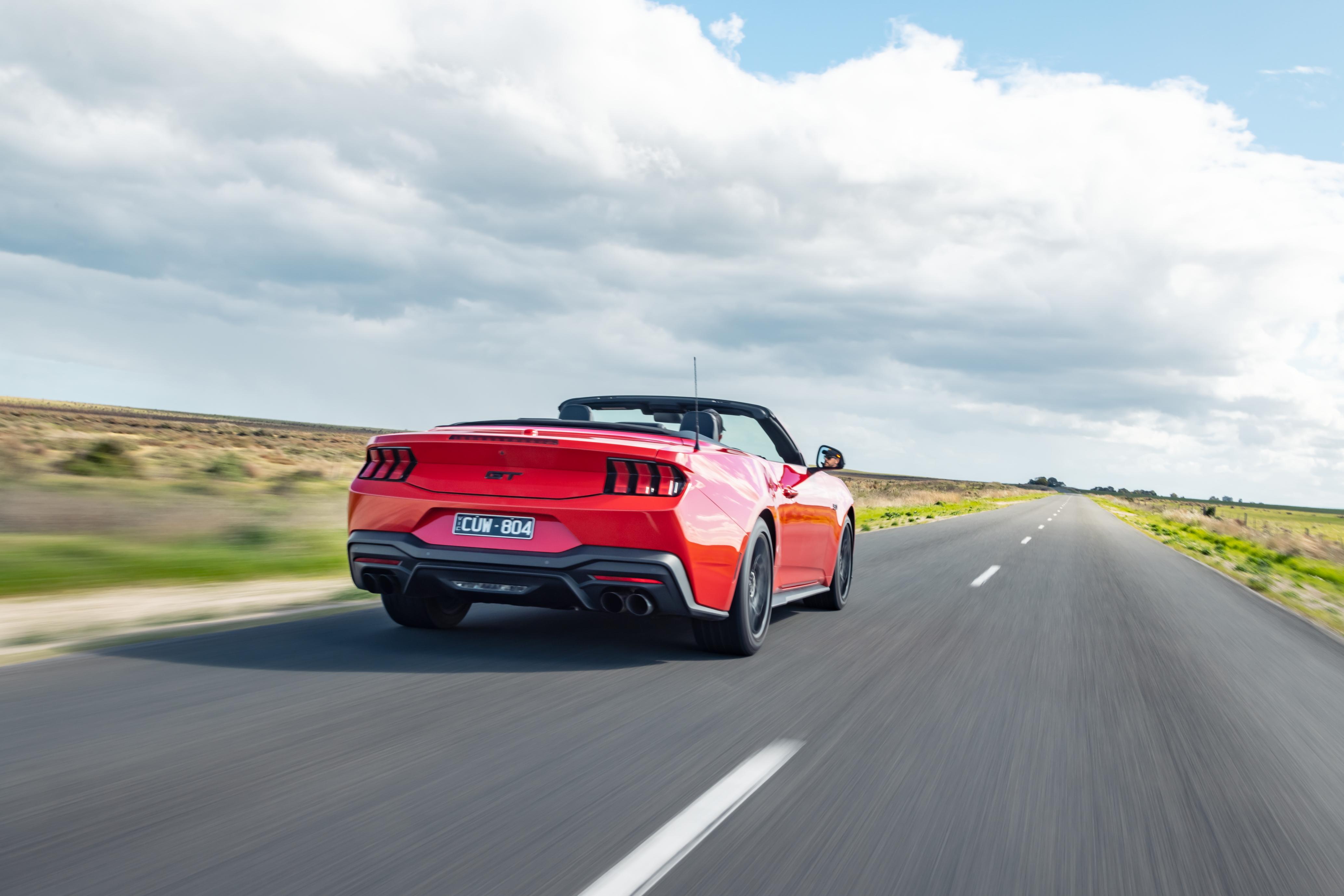
Obviously, a typical nine-to-five office worker can’t spend all their time jaunting through the countryside, especially when they have to pay for their midlife crisis car, so the good news is Mustang isn’t all about the 24/7 party life. The valved exhaust isn’t just there for show; it can tame the raw, guttural V8 roar to a much more socially acceptable level.
Ford has made it as easy as possible to do this too. The Pony button brings up all driving-related settings on the infotainment display, and it’s incredibly easy to not only flick through exhaust valve positions but also between cluster themes and the various track apps available.
It’s all very accessible and makes it easy to customise the ride to your specific needs. For example, you can also program the car to always start in Silent mode at certain times of the day, which is helpful if you leave for work before sunrise.
Even in its quietest mode, the GT’s Coyote V8 is a fantastic engine to live with. In a world of turbochargers and downsized four-cylinders, there’s nothing that quite compares to the immediate and linear power delivery of a free-breathing V8.

It’s part of what makes the Mustang unique, giving it the soul and character it’s renowned for. Every cold start is intoxicating, and the way it pulls strongly from low revs and the more lively mid-range, then up past 7000rpm to the wild and almost unhinged redline is uniquely satisfying.
It’ll happily do that all day long as well, with no indication that it’s ever struggling or asking for mercy. Throttle modulation is the key to best results though, because Ford’s traction control system is fairly liberal – it’s easy to light up the rear tyres from a standstill or out of tight bends, even with sticky Pirelli rubber, but it’s a reminder the car is alive and suits the muscle car mantra well.
The only problem is that 10 gears is still way too many, especially for an engine producing this much torque. In everyday driving it does take away from that linearity, with its constant shifting becoming a little obnoxious in urban environments.
We were also surprised to find the car cruising in seventh gear at just 60km/h, which seems excessively biased towards economy for a sports car like this.
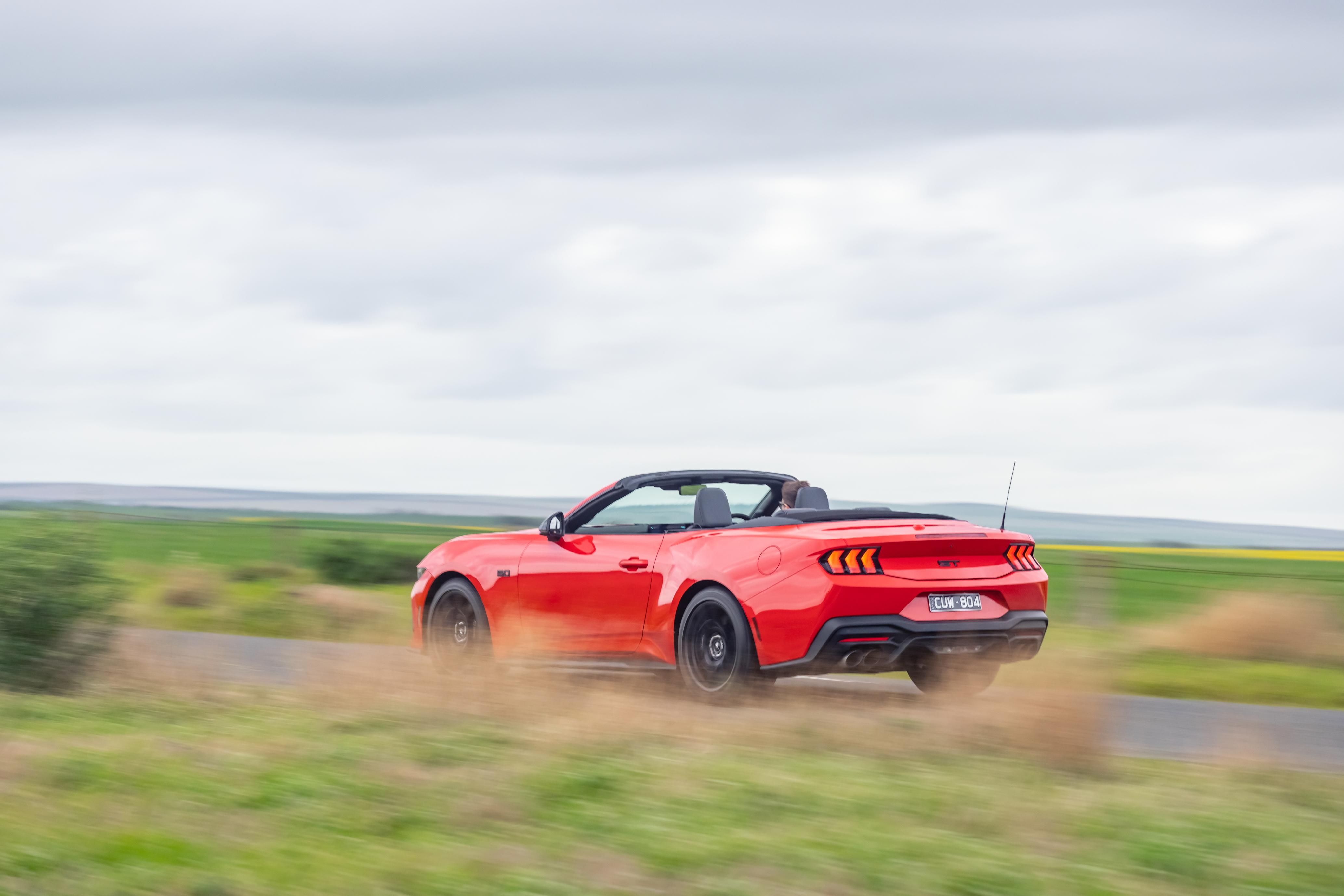
Those 10 gears do keep the engine from getting too raucous in traffic, however, and it’s still a smooth unit that doesn’t do anything unexpected. It also responds well to throttle inputs, and you hardly notice it during high-intensity driving in any of the car’s sportier modes.
The Mustang’s chassis is more than capable of handling aggressive driving too. Ford’s advanced MagneRide adaptive suspension damping system isn’t available for the GT Convertible, presumably due to packaging constraints with the roof mechanism, but it’s still pointy, spritely, and comfortable.
This is a big part of what makes the Convertible such a good weekend cruiser. It eats up sweeping bends that would upset many other cars, requiring little more thought than simply pointing and shooting, while steering diligently through twistier sections and always feeling stable.
Of course, it does feel quite wide on country roads, and you always need to be mindful of that loose rear-end when accelerating out of turns. It isn’t meant to be an all-conquering track-focused machine after all; that’s why the Dark Horse exists.
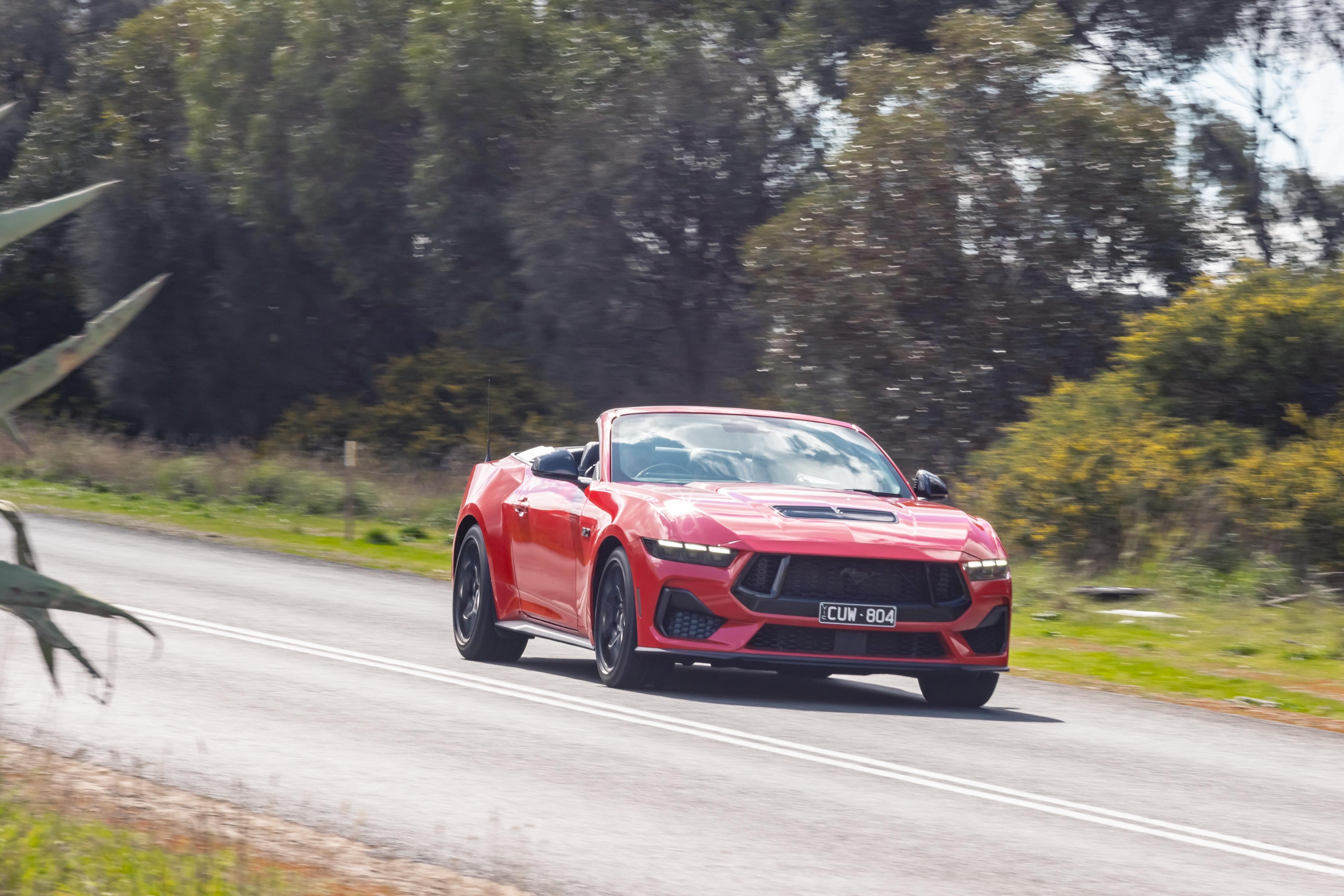
The GT is a much more palatable option for the average driver, primarily because of its sporty yet compliant ride. And despite the lack of a fixed roof, it feels solid and substantial rather than flimsy, cheap or crashy.
But there are limitations, and most come with daily livability. For one, there are significant blind spots with the roof up, which can make it difficult to see what’s around you, especially over your right shoulder.
It’s comparable to the blind spots of a Supra, but at least in that car it is possible to do a headcheck to your right. The Mustang does have blind-spot monitoring to help with this, but it’s not something you should ever have to rely on as a driver.
This is always going to be a limitation in any sleek sports car, though the Mustang Convertible’s small rear window exacerbates it compared to the Fastback. At least you can drop the roof for a full panoramic view.
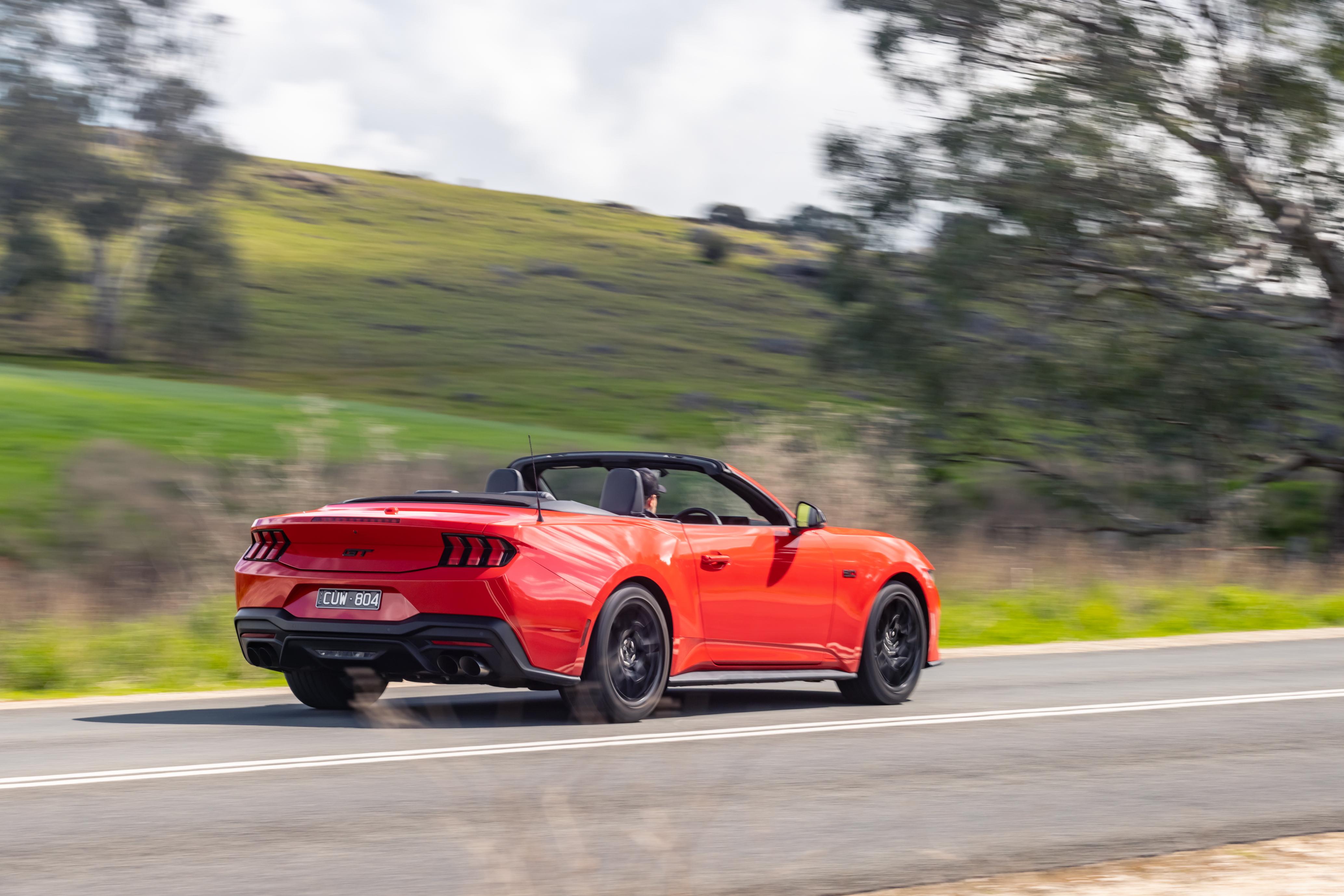
As for safety, the intelligent cruise control system is reliable, following its lane nicely while keeping up with traffic around. I’m not a fan of such functions, but well-calibrated systems like this one make them more convincing.
The remainder of the ‘Stang’s safety systems are generally competent, though we found its passive lane-keep function to be obnoxious. If you stray too close to the white line on the inside of a sweeping bend – particularly on freeways – it pipes up and attempts to steer you back to the middle of the lane.
The only issue is that it doesn’t really do it in a natural way. Instead, it either ‘locks’ the steering, keeping you firmly on the white line, or it tries to steer further towards the inside of the bend, even over the white line.
It’s the only aspect of the car that appears to fight the driver. It doesn’t discriminate either, interfering whenever it thinks you’re crossing the line. Fortunately, it’s easy enough to deactivate, leaving you to enjoy the ride without interruption.
To see how the Ford Mustang stacks up against its rivals, use our comparison tool
What do you get?
Two trim levels are currently available for the Mustang range in Australia.
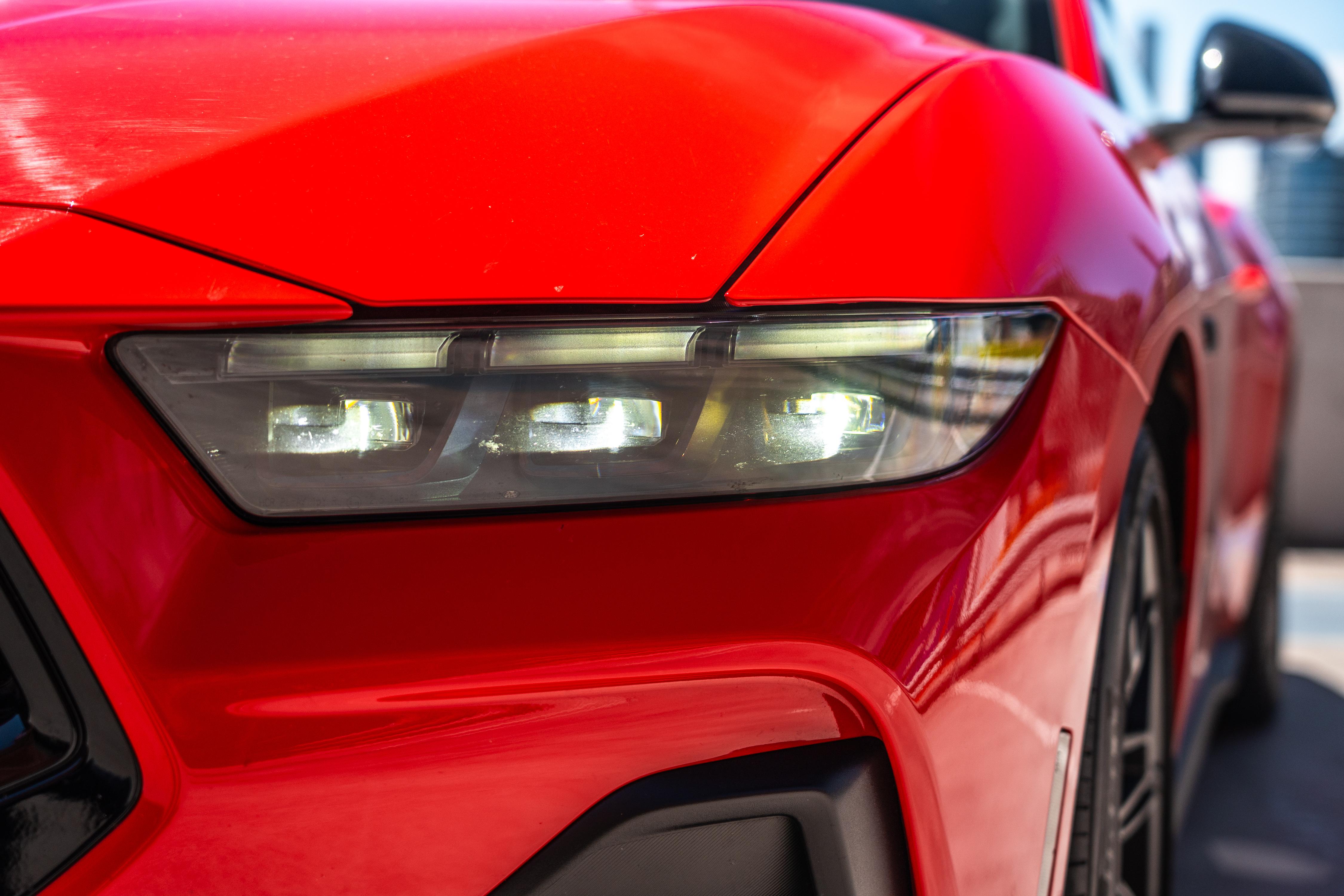
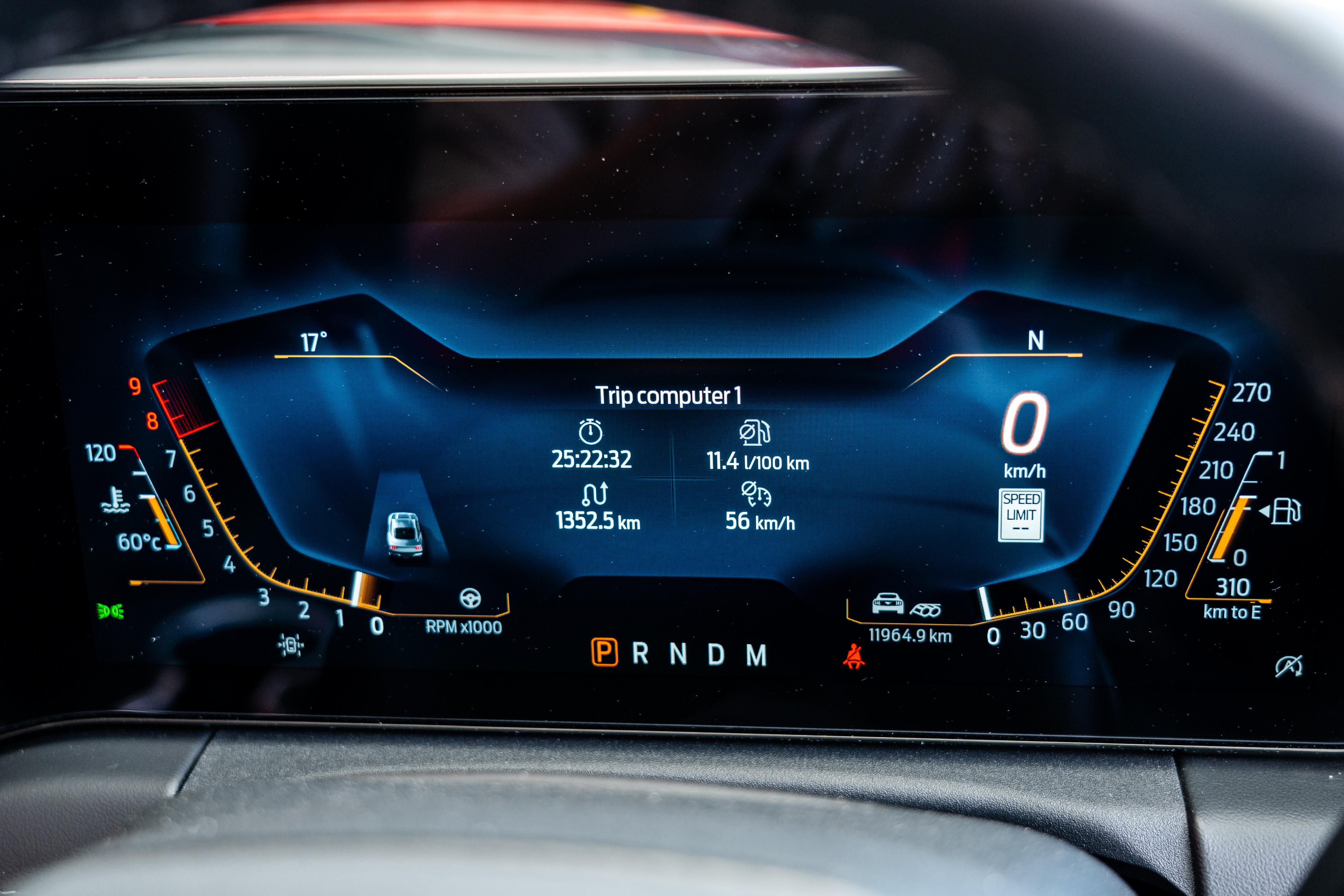
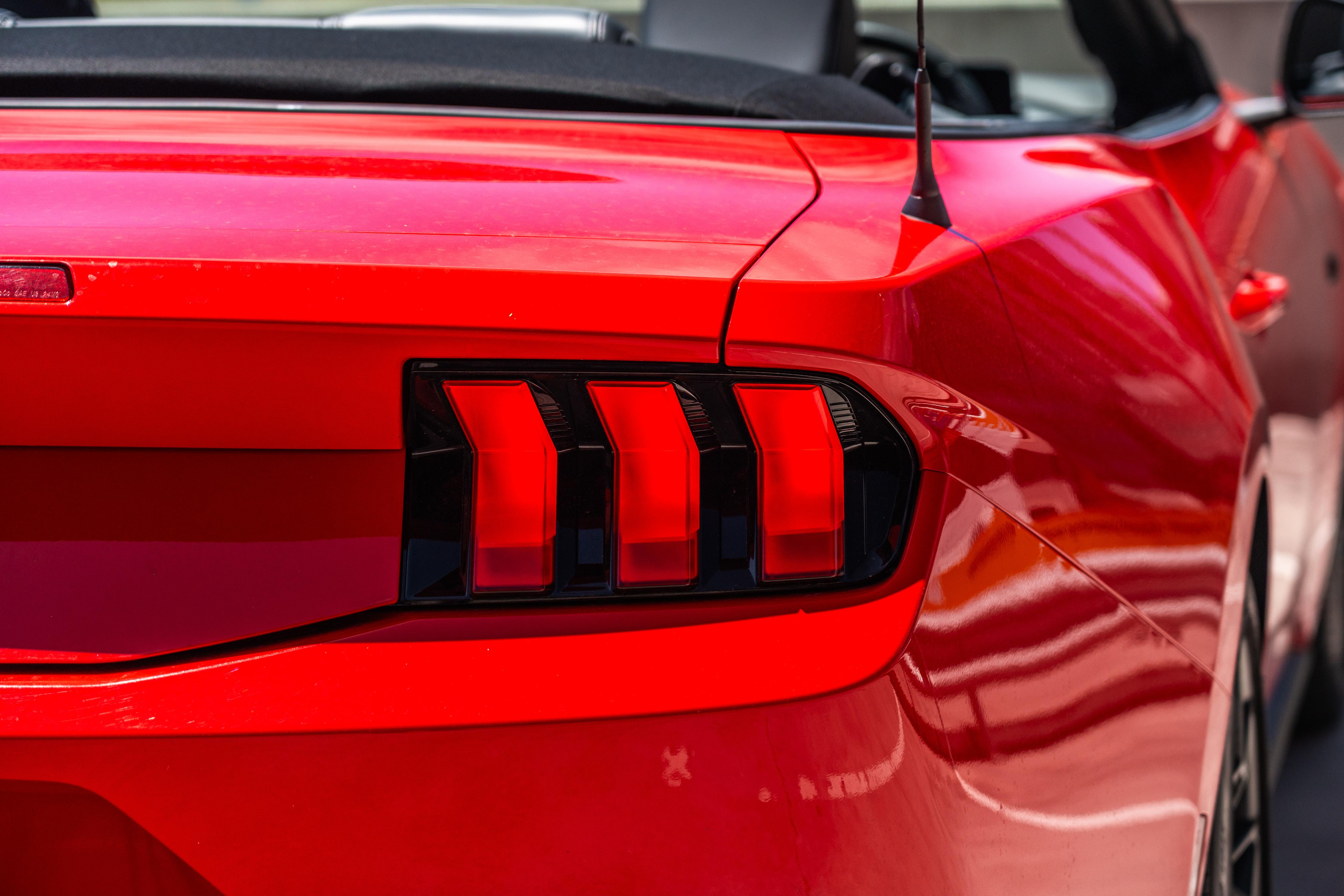

2025 Ford Mustang EcoBoost equipment highlights:
- 19-inch (19-inch x 9.0-inch front and rear) Carbonised Grey alloy wheels
- Brembo six-piston front brake calipers, four-piston rear calipers
- Limited-slip differential
- Electronic park brake with Drift Brake
- Track Apps
- Quad-tip Active Valve Performance Exhaust
- Automatic LED headlights
- Automatic high-beam
- Puddle lights with Mustang logo
- Leather-accented upholstery
- Heated and cooled front seats
- Six-way power driver’s seat with power lumbar, manual backrest adjustment
- Six-way power passenger seat with manual backrest adjustment
- Split-fold rear seats
- 12.4-inch digital instrument cluster
- 13.2-inch touchscreen infotainment system
- Wireless Apple CarPlay and Android Auto
- Satellite navigation
- Wireless phone charger
- DAB+ digital radio
- FordPass Connect embedded modem
- 12-speaker Bang & Olufsen sound system
- Leather-wrapped steering wheel
- Tilt and telescopic steering adjustment
- Leather-wrapped shifter and park brake
- Metal pedals
- Dual-zone climate control
- Electrochromatic rear-view mirror
- Colour-adjustable ambient lighting
- Proximity entry with push-button start
- Illuminated sill plates
- One-touch up/down front windows

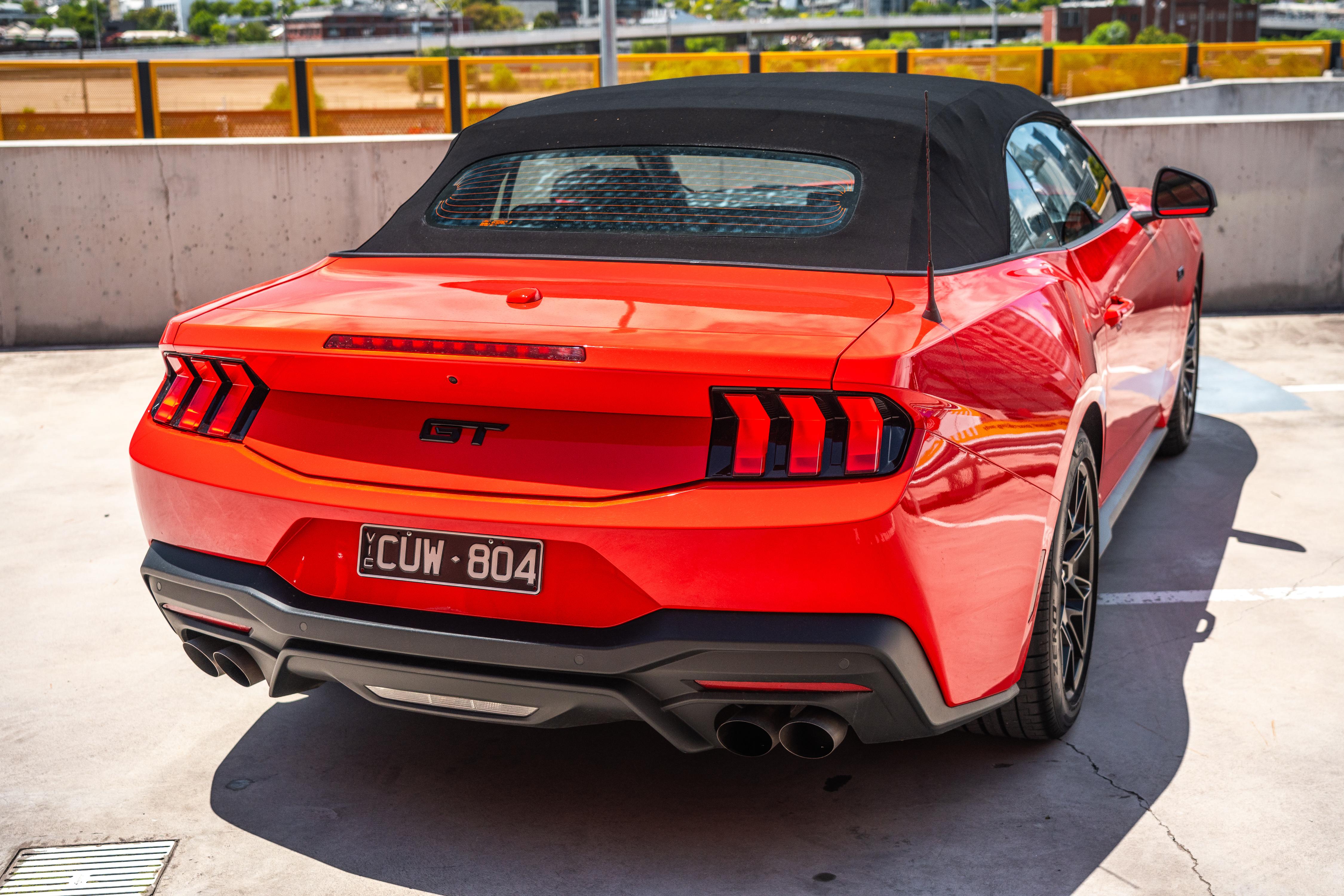
Mustang GT adds:
- V8 engine
- 19-inch x 9.5-inch rear alloy wheels
- Pirelli P Zero tyres
- 6-speed manual variant
- Soft-top convertible roof variant
- Bonnet vents
- Static rear bench seat
- Auxiliary engine oil-cooler
Options
Several option packages and individual parts are available for the 2026 Ford Mustang.
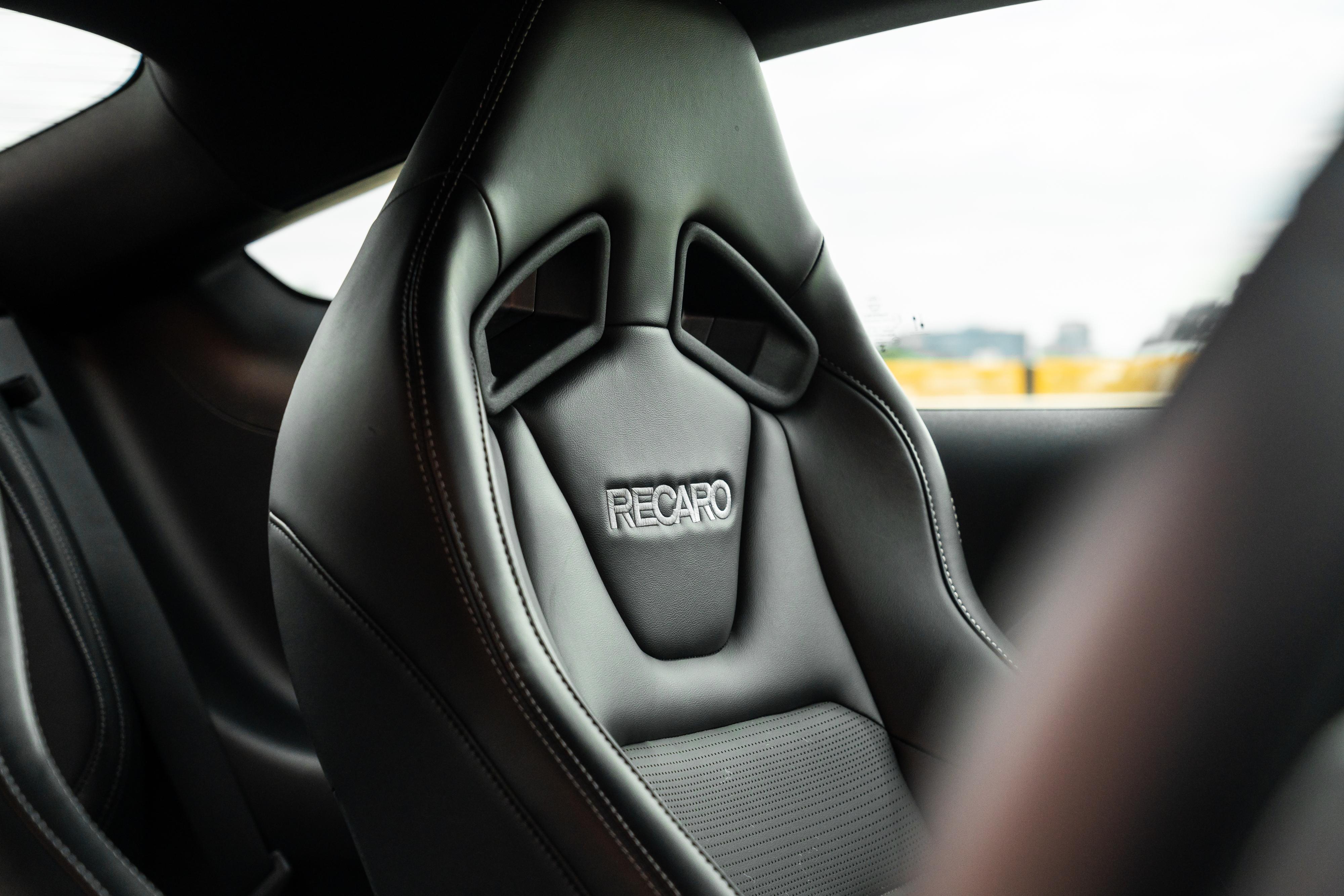
EcoBoost Appearance Pack (EcoBoost only – $1500) adds:
- Black/grey over-the-top stripes
- Unique EcoBoost spoiler
GT Appearance Pack (GT only – $1500) adds:
- Black/grey over-the-top stripes
- Unique GT spoiler
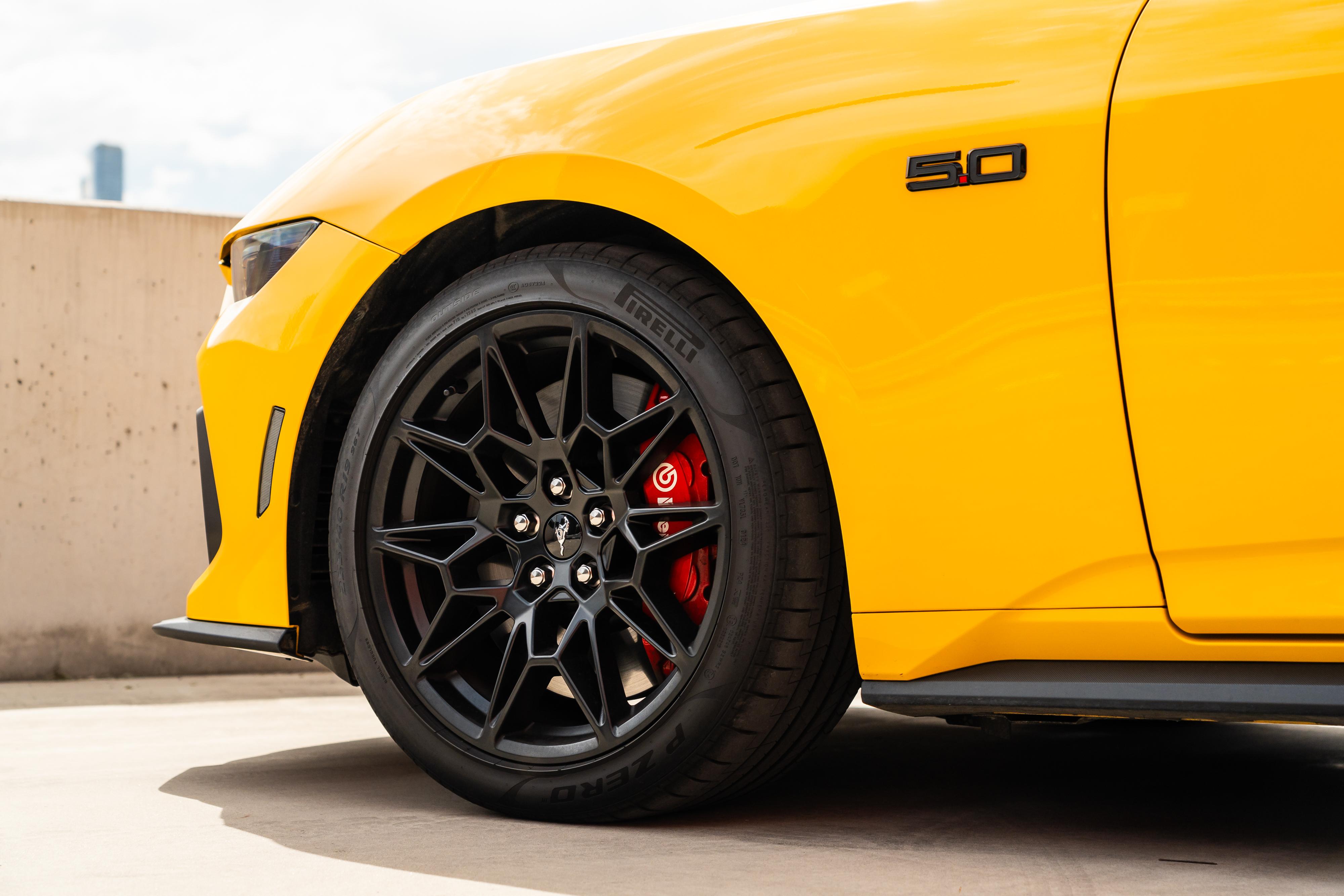
Bronze Pack (GT only – $1500) adds:
- Sinister Bronze alloy wheels
- Sinister Bronze ‘Pony’ (front grille), ‘GT’ (boot lid), and ‘5.0’ (sides) badging
Black Pack (GT only – $1731) adds:
- Black alloy wheels
- Black ‘Pony’ (front grille), ‘GT’ (boot lid), and ‘5.0’ (sides) badging
- Black mirror caps
- Black painted roof (Fastback only)
Other options include:
- MagneRide suspension with red Brembo brake calipers (GT Fastback only) – $2950
- Recaro sports seats (six-way power adjustable, non-heated or ventilated) (GT Fastback only)– $2950
The GT Appearance Pack is not compatible with the Bronze Pack, Black Pack, or MagneRide suspension with red Brembo brake calipers.
To see how the Ford Mustang stacks up against its rivals, use our comparison tool
Is the Ford Mustang safe?
The Ford Mustang has not been crash-tested by ANCAP and is therefore ‘unrated’.
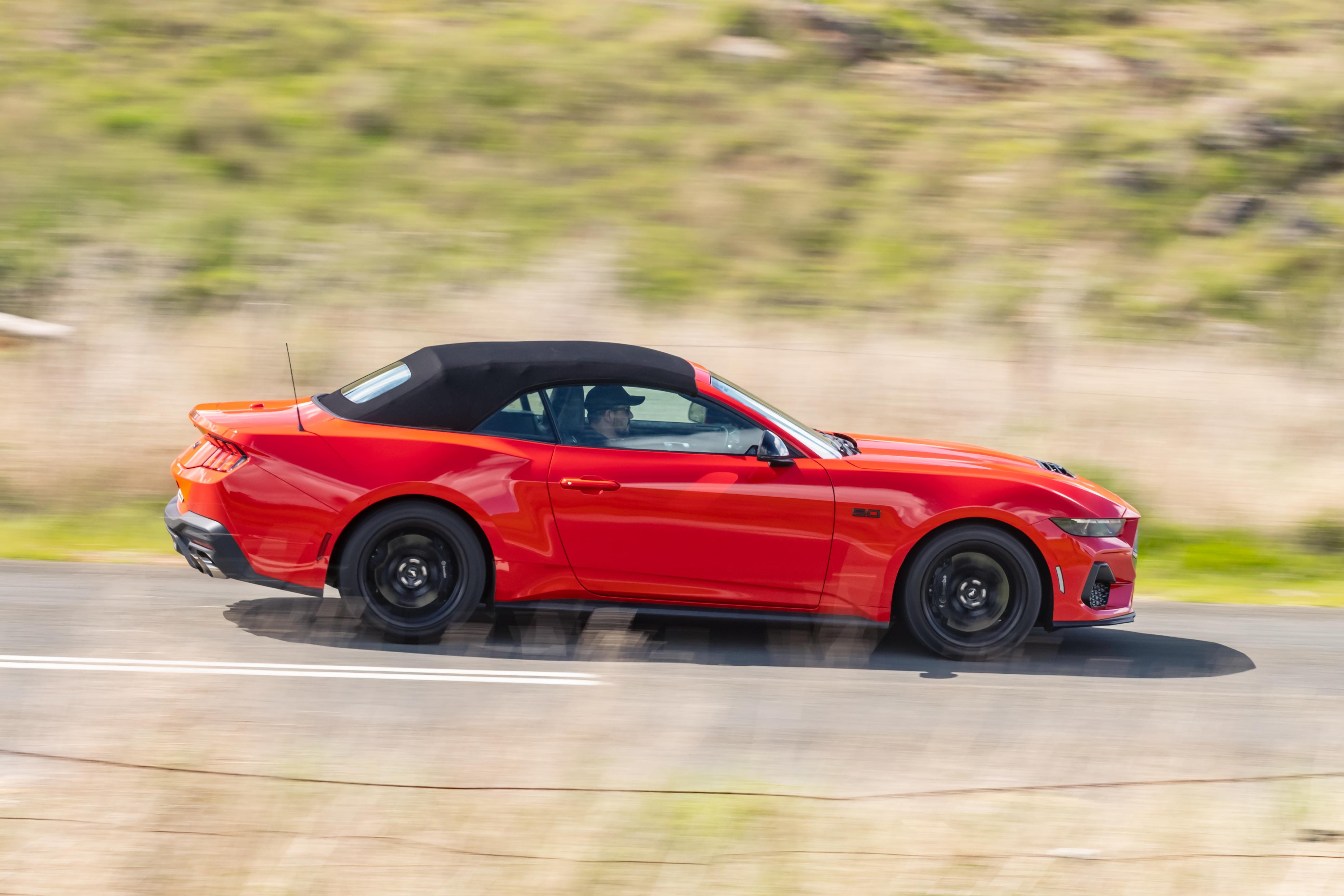
Standard safety equipment highlights:
- 7 airbags, incl:
- Front
- Front-side
- Passenger knee
- Curtain (Fastback)
- Head-side (Convertible)
- Autonomous emergency braking
- Pedestrian detection
- Cyclist detection
- Adaptive cruise control
- Stop/go (auto only)
- Blind-spot assist
- Evasive steer assist
- Deployable bonnet
- Lane centring (auto only)
- Lane keep assist
- Post-collision braking
- Reversing camera
- Rear cross-traffic assist
- Rear parking sensors
To see how the Ford Mustang stacks up against its rivals, use our comparison tool
How much does the Ford Mustang cost to run?
Ford Australia backs the Mustang with its five-year, unlimited-kilometre warranty, while servicing is required every 12 months or 15,000km – whichever comes first.
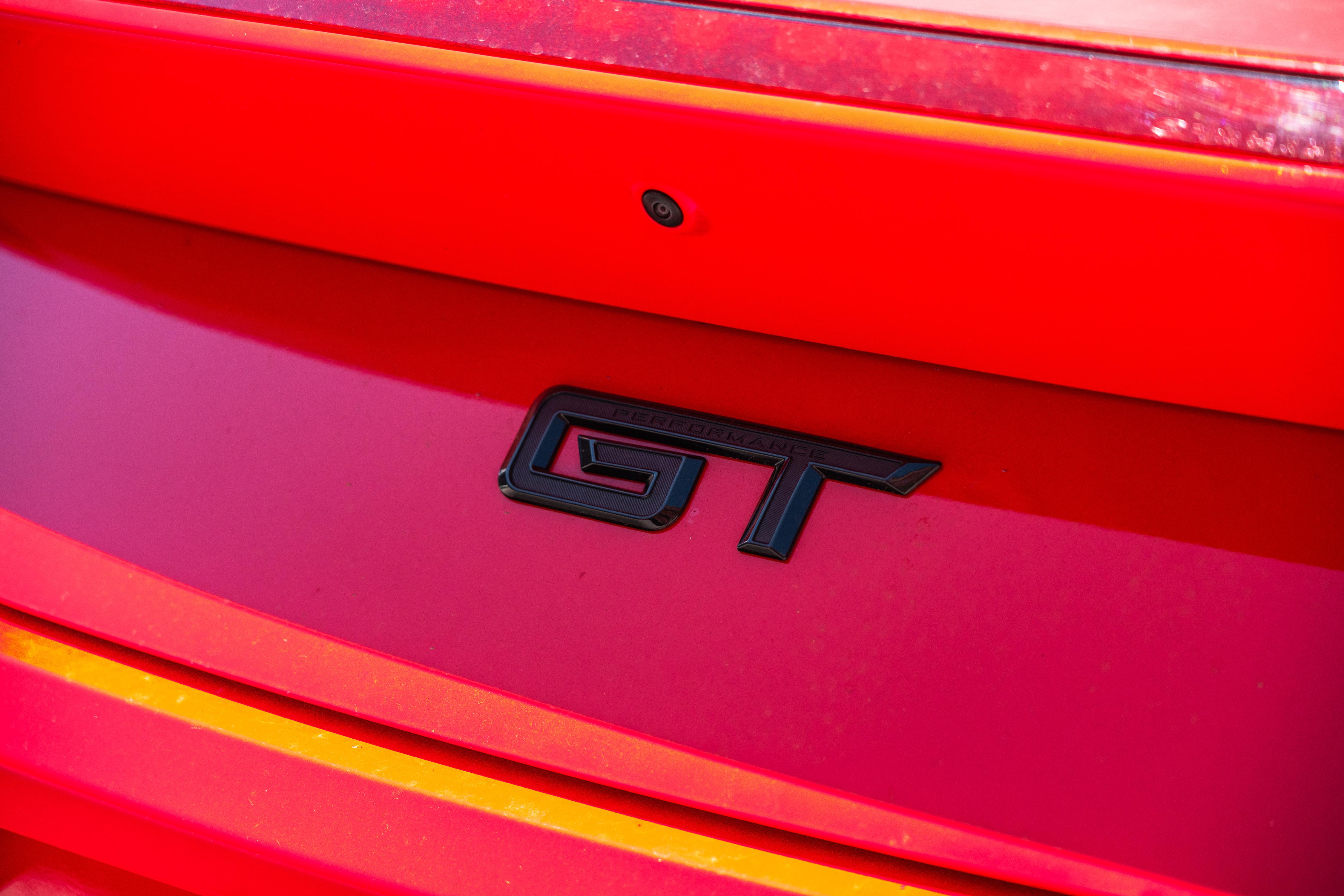
| Servicing and Warranty | Ford Mustang GT Convertible |
|---|---|
| Warranty | 5 years, unlimited kilometres |
| Roadside assistance | Up to 7 years (service activated) |
| Service intervals | 12 months or 15,000km |
| Capped-price servicing | 5-year pre-paid service plan |
| Total capped-price service cost | $1670 |
Ford’s roadside assistance program is extended by 12 months after each service, up to a maximum of seven years.
For context, the five-year service pack for the Mustang EcoBoost costs $1290.
The Nissan Z, meanwhile, costs a total of $2495 to service over five years, as the first five services are capped at $499 each, and its service intervals are 12 months or 10,000km.
To see how the Ford Mustang stacks up against its rivals, use our comparison tool
CarExpert’s Take on the Ford Mustang GT Convertible
The Mustang GT is simply awesome, sweetened by the fact that Ford has continued to stick to the V8 formula even as rivals have disappeared.
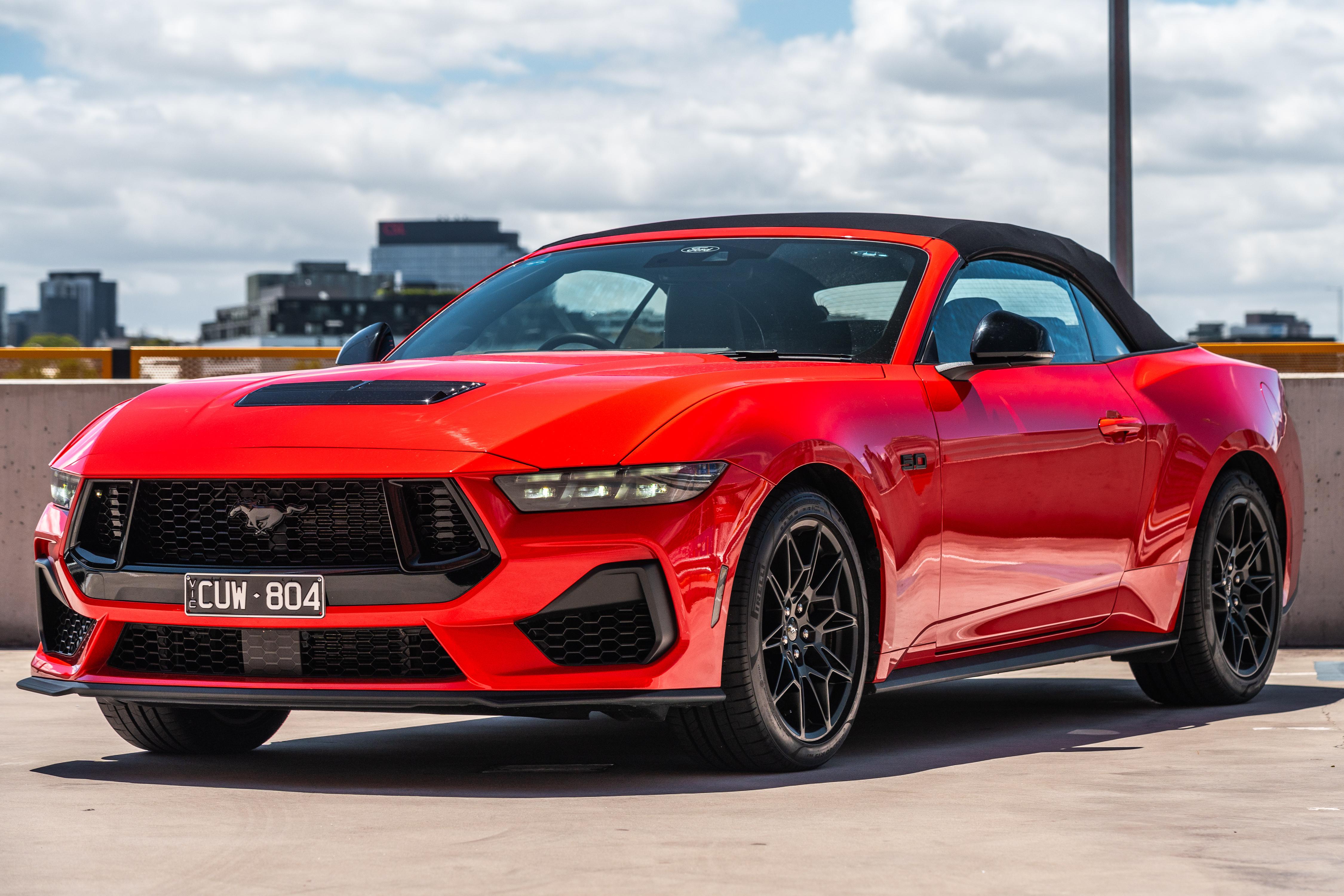
While the EcoBoost is solid, if you get a Mustang without the Coyote you’re simply doing it wrong. Sorry to sound like an elitist, but you’ll know what I mean if you have the opportunity to drive a Convertible.
This engine/bodystyle combination is really where the Mustang shines. But as lovely as it is to drive along with the wind in your hair and sun on your face, the Mustang isn’t unique in that way – you can do that in a Mazda MX-5.
It’s where the V8 makes all the difference, as there’s nothing else out there that gives you the mix of rewarding driving dynamics, impressive performance, and incredible open-air sound for less than $100,000. Or even $200,000, as it turns out.
But that’s part of the issue when it comes to the price tag. Because it has no real competition, Ford is free to price the Mustang wherever it wants.

That’s how we’ve ended up with the Convertible’s unsavoury asking price of $92,667 before on-roads, which is more than $5000 higher than it was as recently as four months ago, and there’s little to stop Ford from pushing it up even further.
Of course, it’s an important caveat that emissions regulations could soon bring the Mustang as we know it to an end. While it is fair to complain about pricing right now, there’s a good chance we won’t be able to by a new V8 Mustang five years from now.
For now, the Mustang GT is still as tough and exhilarating as ever, and the Convertible version remains a great fair-weather weekend cruiser. It’s also a worthy evolution of the roof-down cruising culture that the first Mustangs helped popularise in the 1960s, with a soundtrack that’s more addictive than ever.
While the Dark Horse may be sharper and more brutal, the GT Convertible is the best way to enjoy the Mustang if you’re partial to rear-drive V8s and sunny countryside drives.

CarExpert can save you thousands on a new Ford Mustang. Click here to get a great deal.
Click the images for the full gallery

